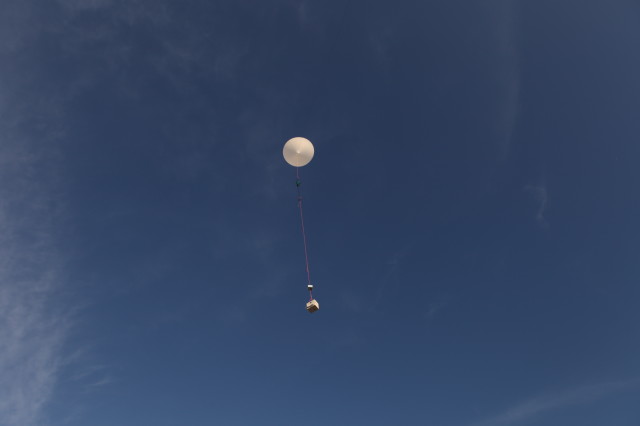Thursday, July 04. 2013
Via Creative Applications
-----
By Filip Visnjic

Eyes on the Sky is a process-based investigation into generative design and the weather linking 64 public-access web cameras across Europe, recording the colour of the sky and producing a book that collects a week of paintings where cameras paint the weather. 
Friday, May 24. 2013
Via BLDGBLOG
-----
de noreply@blogger.com (Geoff Manaugh)
 Photo courtesy Scott McGuire. Photo courtesy Scott McGuire.
(This interview originally published on Venue).
Several years ago, while I was still on the editorial staff at Dwell magazine, I took a daytrip down to the head office of The North Face to visit their equipment design team and learn more about the architecture of tents.
"As a form of minor architecture," the resulting short article explained, "tents are strangely overlooked. They are portable, temporary, and designed to withstand even the most extreme conditions, but they are usually viewed as simple sporting goods. They are something between a large backpack and outdoor lifestyle gear—certainly not small buildings. But what might an architect learn from the structure and design of a well-made tent?"
Amongst the group of people I spoke with that day was outdoor equipment strategist Scott McGuire, an intense, articulate, and highly focused advocate for all things outdoors. As seen through Scott's eyes, the flexibility, portability, ease of use, and multi-contextual possibilities of outdoor equipment design began to suggest a more effective realization, I thought, of the avant-garde legacy of 1960s architects like Archigram, who dreamed of impossible instant cities and high-tech nomadic settlements in the middle of nowhere.
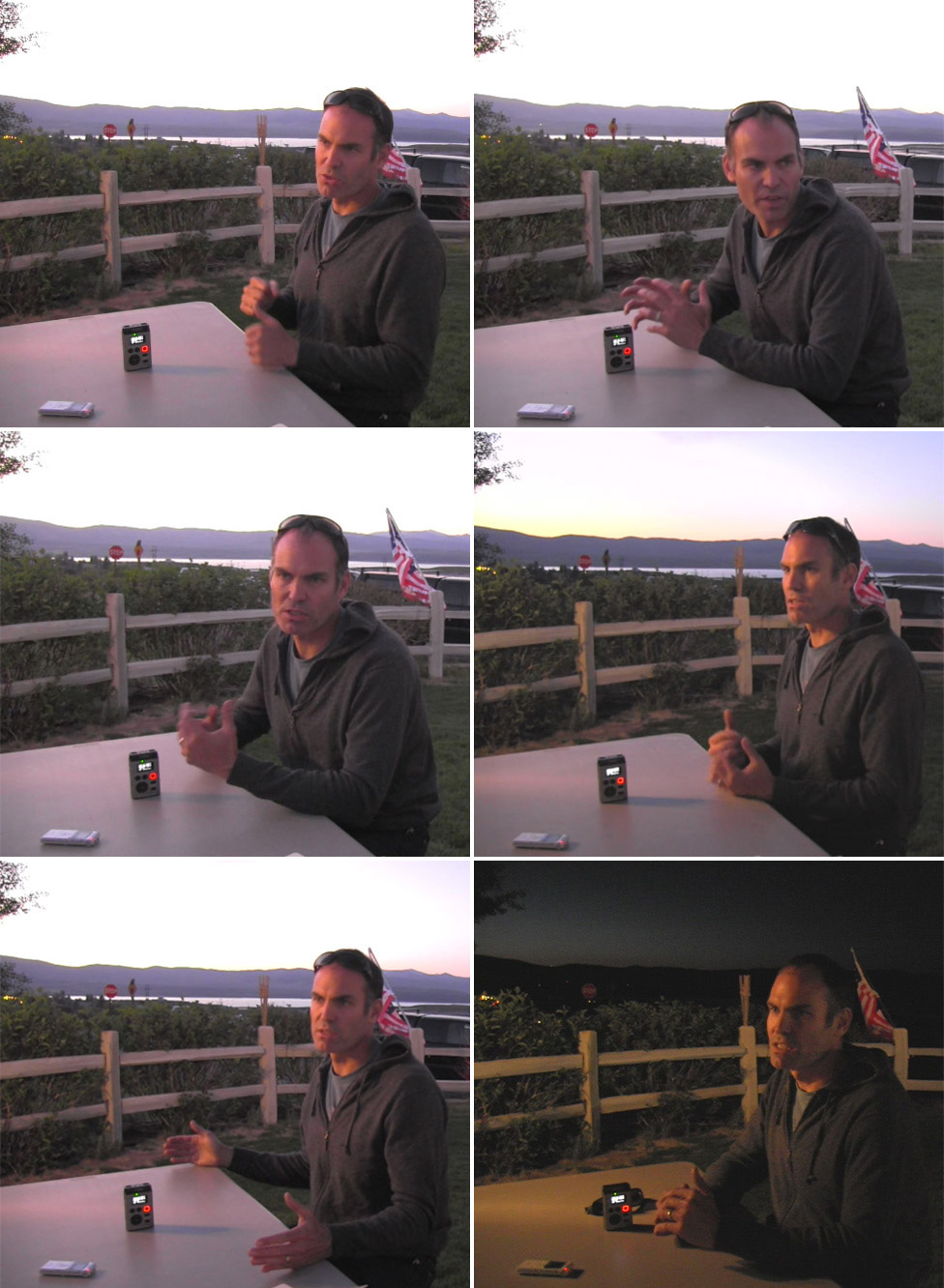 Scott McGuire talks to Venue in Lee Vining, California; Mono Lake can be seen in the background. Scott McGuire talks to Venue in Lee Vining, California; Mono Lake can be seen in the background.
Intrigued by his perspective on the ways in which outdoor gear can both constrain and expand the ways in which human beings move around in and inhabit wild landscapes, and traveling with Nicola Twilley as part of our collaborative Venue project, I was thrilled to catch up with Scott at a deli in Lee Vining, California, near his home in the Eastern Sierra.
McGuire, who recently left The North Face to set up his own business, called The Mountain Lab, was beyond generous with his time and expertise, happily answering Nicola's and my questions as the sun set over Mono Lake in the distance. His answers combined a lifelong outdoor enthusiast's understanding of the natural environment with a granular, almost anthropological analysis of the activities that humans like to perform in those contexts, as well as a designer's eye for form, function, and material choices.
Indeed, as Scott's description of the design process makes clear in the following interview, a 40-liter mountaineering pack is revealed literally as a sculpture produced by the interaction between the human body and a particular landscape: the twist to squeeze through a crevasse, or the backward tilt of the head during a belay.
Our conversation ranged from geographic and generational differences in outdoor experiences to the emerging spatial technologies of the U.S. military, and from the rise of BMX and the X Games to the city itself as the new "outdoors," offering a fascinating perspective on the unexpected ways in which technical equipment can both enable and redefine our relationship with extreme environments.
• • •
Geoff Manaugh: I’d like to start by asking you about the constraints you face in the design of outdoor athletic equipment, and how that affects the resulting product. For instance, in designing architecture, you might think about factors such as a building’s visual impact, its environmental performance, or the historic context of where your future structure is meant to be. But if you’re designing something like a tent—a kind of athletic architecture, if you will—then you’re talking about factors like portability, aerodynamism, cost, weather-proofing, etc.. What design constraints do you face, and how do you prioritize them?
Scott McGuire: The first thing is always the user. Everything has to be very user-centric, in a way that’s perhaps unlike conventional architecture. You might say, “I’m building a house; it’s about this site; it’s about this view; people are going to live in it in a certain way,” but you would rarely design a house based on whether or not someone has a propensity, for example, to use their kitchen utensils with their left hand or their right hand. But when you’re creating a technical product, you become really myopically focused on how that product interacts with an individual. It’s about establishing who that person is.
Of course, if I’m talking about doing a small technical pack that will hold 40 liters for someone who’s going mountaineering—well, I know that same pack may very well be used by someone riding on a bike as a commuter in New York City. Still, when we’re talking about that product, it’s very much about things like: what’s the person who’s going mountaineering wearing? What are they carrying? Where are they going? What environment are they going to be in? How much wear and tear is their pack going to get? As you study the user, you usually end up discovering a lot of nuances about the way they’ll use the product, and they’re often things you wouldn’t normally think about.
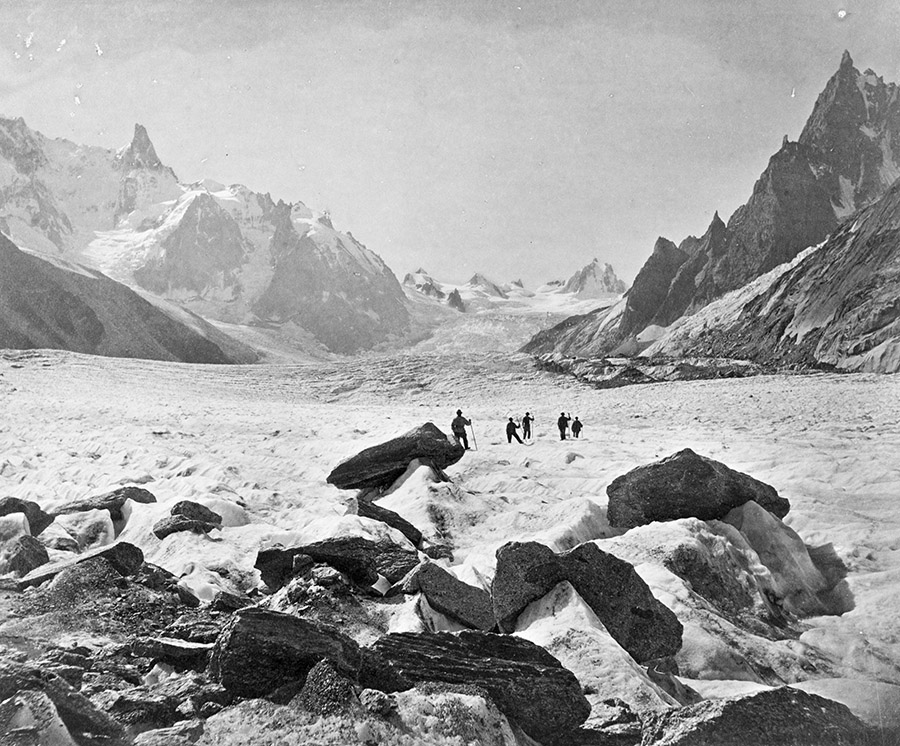 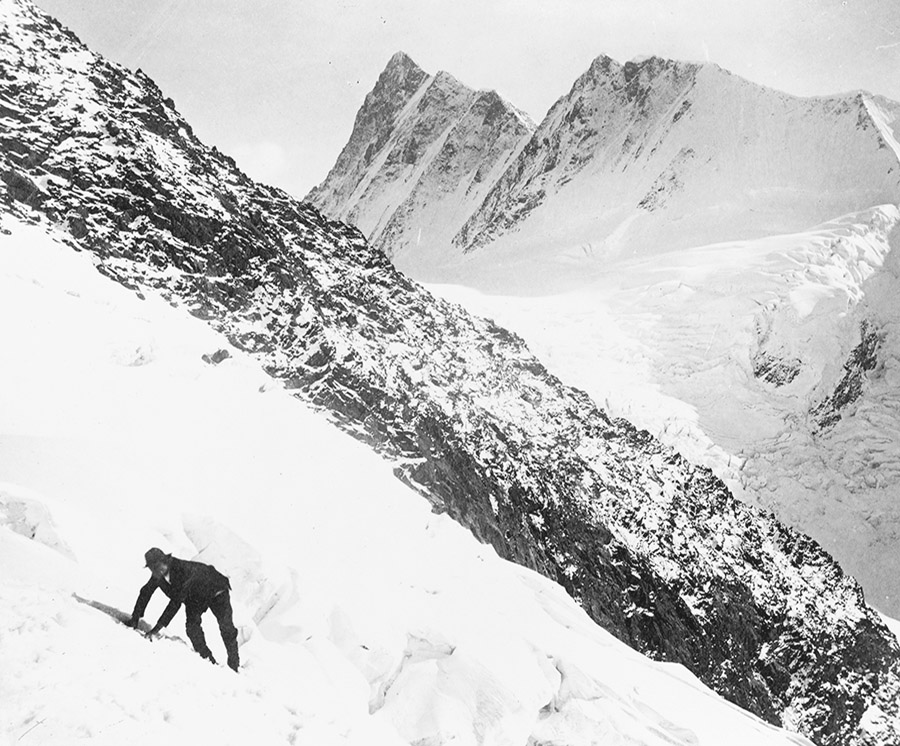 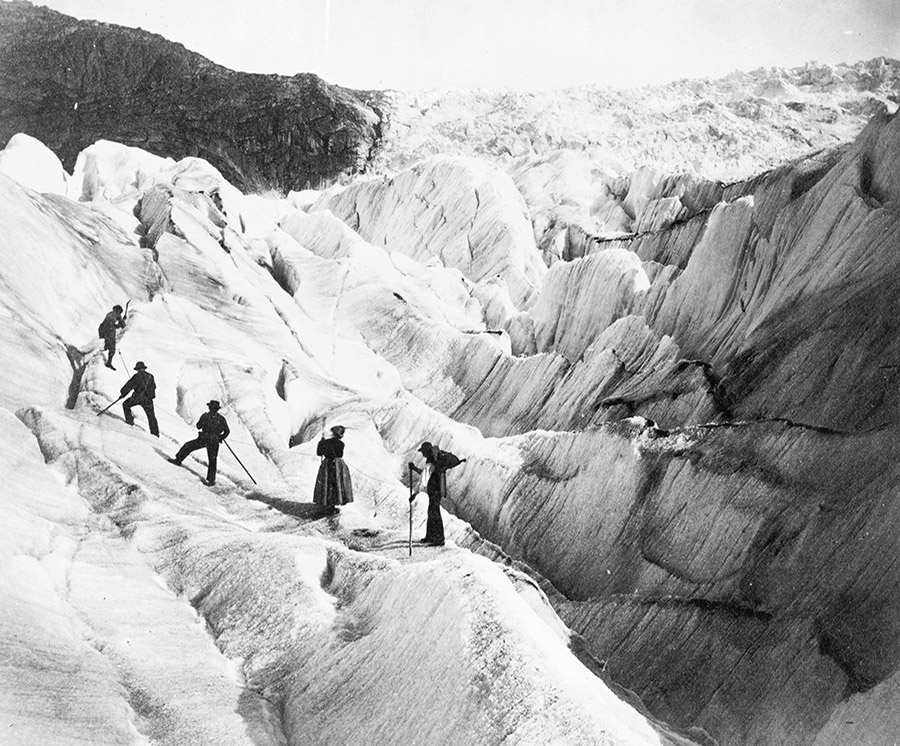  "Mt. Blanc from Le Jardin"; "The Finsteraarhorn"; another view of the Finsteraarhorn; and "Glacier of the Rhone." All photos taken between 1860 and 1890. Courtesy of the U.S. Library of Congress Prints and Photographs Division. "Mt. Blanc from Le Jardin"; "The Finsteraarhorn"; another view of the Finsteraarhorn; and "Glacier of the Rhone." All photos taken between 1860 and 1890. Courtesy of the U.S. Library of Congress Prints and Photographs Division.
I’ll give you some examples of how that would work. I’ll stick with the 40-liter technical pack, which is the one you usually find in an area that’s high alpine, above 8000 feet, with year-round glaciers, where there’s lots of climbing and mountaineering. What you’re going to find, obviously, is that people are carrying it. They’re moving at a relatively athletic pace. They want to have the ability to fit the pack.
When we think about fit, it’s not as simple as saying: “This person’s got a 34" waist, a 19" back, a 42" chest, and that’s what we need to focus on.” It’s also the fit based off the way someone moves—what I would call the interaction between the user and the device. The way a 65-liter pack fits someone who’s walking down a manicured trail, doing eight miles a day—the height that their knee climbs and the amount that their body twists—is different than the fit of a 40-liter pack for somebody who’s going up a mountain, where they might be climbing a 45-degree slope. Or they might have somebody on belay and they need to be able to look up, so they need to have a tiny pocket of space so that, with a helmet, they can crane their head back and look up at their partner. The pack can’t get in the way of that.
 Three 65-liter packs by The North Face, High Sierra, and Kelty, respectively. Three 65-liter packs by The North Face, High Sierra, and Kelty, respectively.
Then you add to all that not just an ability to carry weight, but questions like: what does it feel like when an arm comes up to reach for a hold? Or: what happens when you’re trying to twist through a crevasse? There’s a fair amount of time spent really thinking about all of those elements on the body.
And then you run into some really interesting places when you start thinking about how the pack comes off the body. What does everybody do when they come to a stop? They take their packs off, throw them on the ground, and sit on them. So you have to think about how your frame system can carry the load one way, while being carried on someone’s back, but also what happens to that frame system when someone sits on it when it’s on the ground. That really nice zipper pocket on the face, the one that’s so great for getting access at the front of the pack—well, what happens when that thing spends a year lying zipper-down, crammed full of mud, with 150 to 200 pounds of person sitting on top of it? A lot of these observations need to take place in the very beginning, to think through these things.
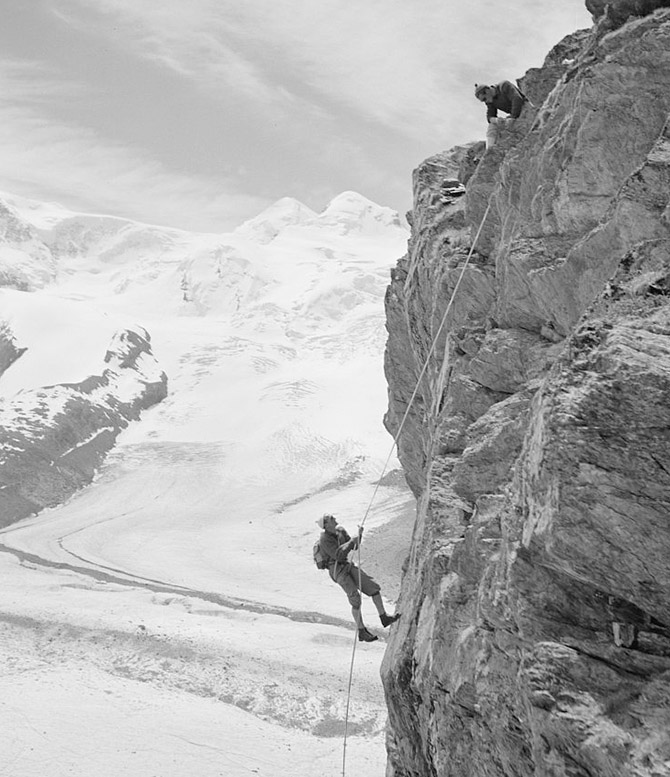 Mountain climbers, Zermatt, Switzerland (1954); photograph by Toni Frissell, courtesy of the U.S. Library of Congress Prints & Photographs Division. Mountain climbers, Zermatt, Switzerland (1954); photograph by Toni Frissell, courtesy of the U.S. Library of Congress Prints & Photographs Division.
That’s basically the fit component of the interaction to the person. The second element is really going to be: what goes into the product? What is the user carrying, and how do they access it? Those two questions live in a symbiotic relationship with each other. It’s also not just about what goes in the pack, but when it goes in, when it comes out, and how it goes back in again.
Taking a conventional top design, you have an open bucket; you open the lid; and you put stuff inside. There are shapes that inherently lend themselves to technical packs: they’re slightly tapered at the bottom, so they stay within the lumbar area, keeping the weight centered over the sacrum. That makes it a little easier when those narrow slots are on your waist, and the V-shape of the pack mimics the shape of your shoulders and chest. What it also does is it creates a bucket that can feed stuff down into the bottom. You want to keep your heavier stuff near your center of gravity—you want to keep it low and tight—preferably right underneath the shoulder blades.
But you also need to think about what’s going in there, in what order. Things like an extra shell, or your spare jacket, or the rope you may or may not need—those can all go in the bottom. But what are the things that are coming on and off, all the time? On a technical climb, if you’re wearing a puffy jacket, well, every time you’re hot, that jacket’s going to come off—maybe ten or fifteen times a day. So how does that go in and how do you maintain access to it in the easiest possible way? How do you make sure you’ve got easy access to things like a first aid kit, in case you’ve got to get to it quick? Where does your headlamp sit so that, when it’s late and you’re finally getting the headlamp out, and it’s probably already dark, you know, intuitively, that it’s in this pocket right here and you don’t have to fumble around and find the headlamp and risk having everything else dump out?
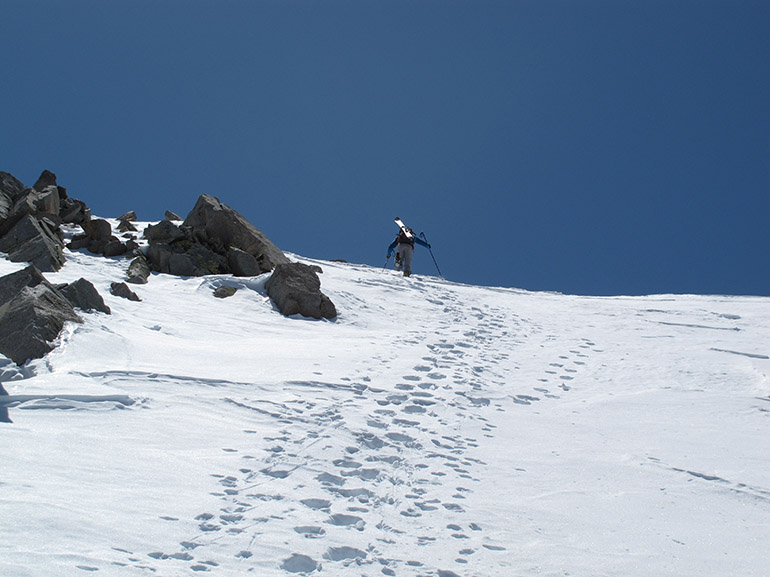 The view from Scott McGuire's back porch; photo courtesy Scott McGuire. The view from Scott McGuire's back porch; photo courtesy Scott McGuire.
And then there are even simpler things, like small pockets for access to things like a point-and-shoot camera that can go in and out quickly, or your lip balm, or that nutritional bar that allows you to get a shot of quick energy. A lot of thought needs to go into where those things go—where pocketing and storage should be, both from an organizational standpoint but also from a load-dispersion standpoint. These are all maybe a little comparable to how an architect might think: it’s about organizing the space, but down to a level of detail that takes into consideration very different people doing very different things with their gear.
Once you’re talking about the load—about what you’re carrying and how that gets managed—the next thing is going to be materials. The materials are so important. Like in conventional architecture and design, materials obviously have an aesthetic appeal. On the business side of it, the value equation is always about cost versus value. For example, there are things that can cost very little but have a very high value based off their perceived benefit: they’re lightweight, durable, attractive. Things can also have a very high cost but not necessarily have a value that the customer perceives, such as highly technical specialized fabrics that may not really contribute a benefit to your average end user. The benefit’s lost. It’s as if you build a house and you install gold pipes—no one sees it. Do they really make the water taste better?
You need to be really careful about those decisions. When you’re talking about the material selection and if somebody has to carry it, then there’s a balance not only in terms of cost versus value, but also around weight versus durability. In a general analysis, you’ve got price, weight, and durability—and, usually, you only get to pick two. You want something that’s really cheap and super lightweight? You give up durability. You want something that’s super durable and incredibly lightweight? It’s going to cost you a lot of money—you give up price.
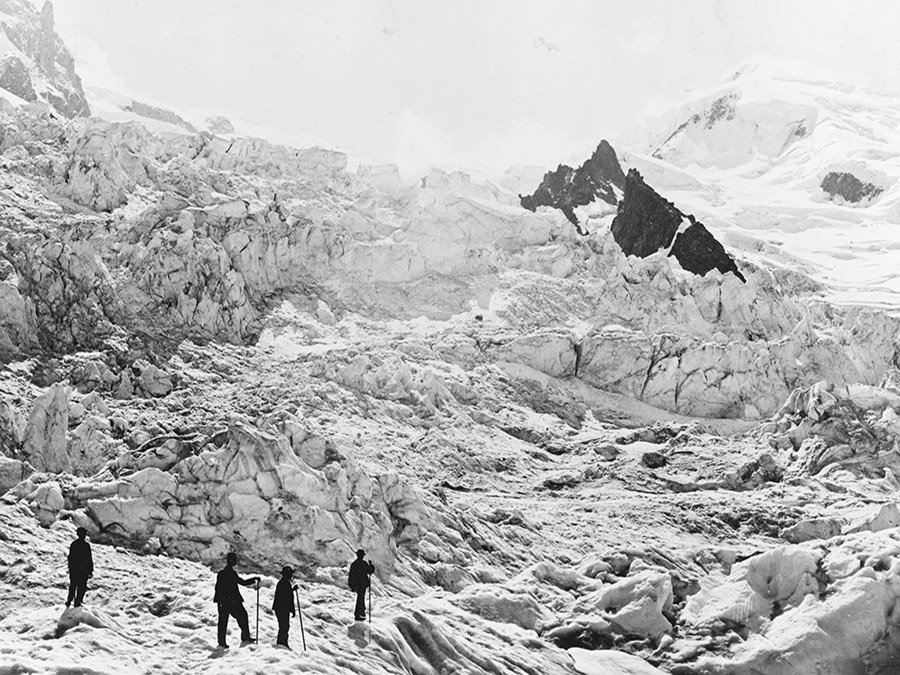 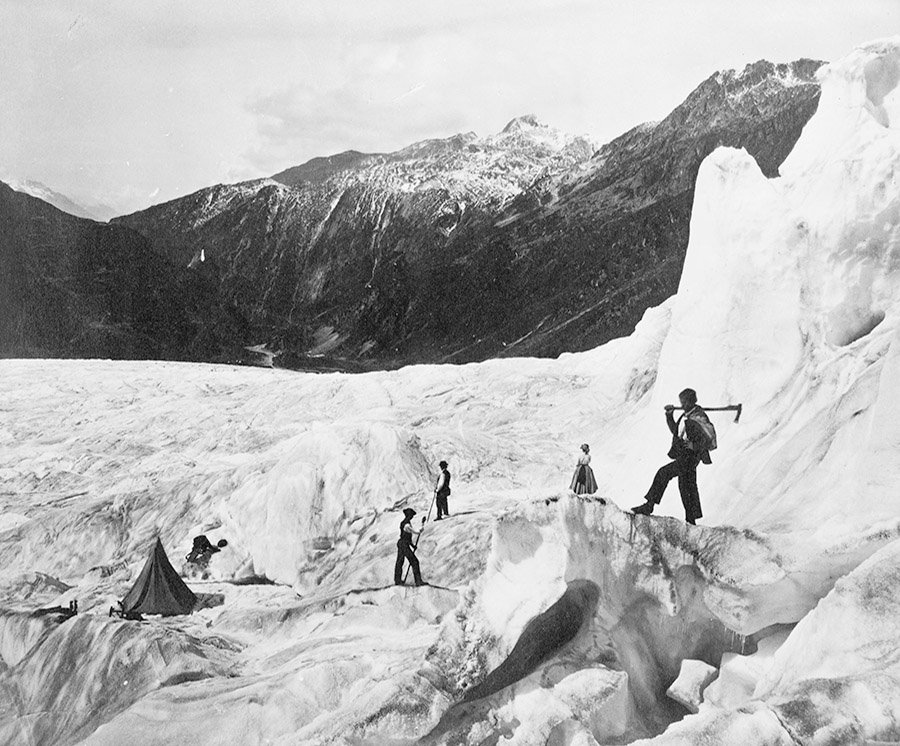 "Ascension of Mt. Blanc" and Glacier of the Rhone." Photos taken between 1860 and 1890. Courtesy of the U.S. Library of Congress Prints and Photographs Division. "Ascension of Mt. Blanc" and Glacier of the Rhone." Photos taken between 1860 and 1890. Courtesy of the U.S. Library of Congress Prints and Photographs Division.
To get back to the example of a 40-liter mountaineering pack, that customer typically is investing in a product that is high-quality, with high-durability, designed to take a lot of abuse. And there’s an expectation there that a slightly more expensive product, with greater durability and less failure potential, has higher value. It’s worth the extra money. There’s a huge difference between someone who’s going for their very first backpacking trip versus the person who’s been training for an objective for the last year. That person doesn’t want, after all the hours spent planning, looking at topo maps, and waiting for the weather window, to be hampered by gear. That person’s going to choose quality and durability over price.
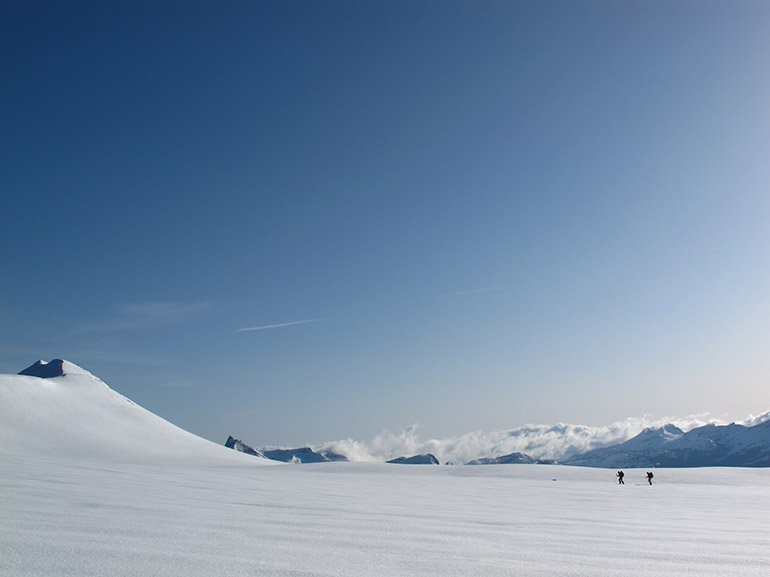 Photo courtesy Scott McGuire. Photo courtesy Scott McGuire.
Manaugh: When it comes to materials, I’m curious if there are things that you or the designers you work with are aware of, that are perfect for certain functions, but they’re so expensive or simply so foreign to the average consumer that the market can’t bear them. In other words, how do you navigate the market with new materials and new designs?
McGuire: One of the Holy Grails here, from a design standpoint, is the side-release buckle. From a functional standpoint, the ability to have a buckle, pop it, have it separate, put it back together, click it, including that audible signal that it’s now secure—that has a simplicity and intuitiveness to it. I think a lot of people in design still look at that and say, gosh, that’s one of the things that’s been around for a long time. But is it the best solution?

It’s always a question of whether you’re building a better mouse trap, or if you’re just trying to do something that’s different—something that’s gimmicky. You’re always balancing what’s unique for the sake of being unique—not necessarily because it’s providing a better solution—versus what’s unique because it’s actually offers a functional improvement.
There are a couple of examples like that. Nobody’s really figured out a better solution than a zipper. But zippers fail; they wear out over a certain period of time. The side-release buckle is a design that is ubiquitous across all packs, and there are different aesthetic treatments to it, but, functionally, they all do the same thing: a two-part click. But there are always people exploring what could be better in that space.
Manaugh: One of the things we talked about a few years ago when I first met you at The North Face was that there are differences in tent design between the North American and the European markets. You mentioned then that, in Europe, campgrounds are so crowded that a different level of privacy is expected from a tent, whereas, in the U.S., you can get away with using much more transparent materials, because you might be the only people at a certain campsite for two or three nights in a row and you don’t need as much privacy.
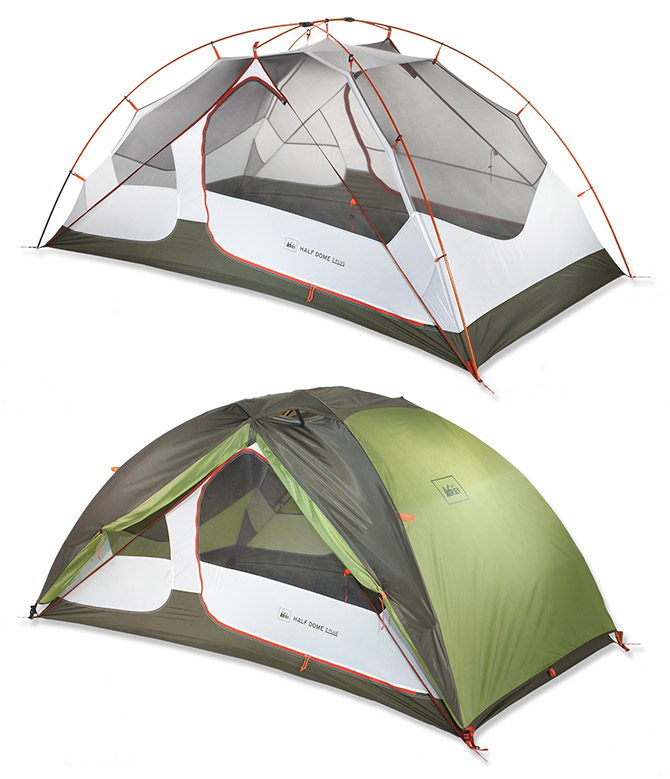 The REI Half Dome 2 Plus Tent, with and without cover; via REI. The REI Half Dome 2 Plus Tent, with and without cover; via REI.
I’m curious, now that you’re doing consulting with different companies, different regions, and different markets, how these sorts of cultural differences play out in the design of outdoor equipment in general.
McGuire: The commercial world has gotten a lot smaller, and the ability now to connect with people in those very different cultures has become much more commonplace. That’s true everywhere, I think. I mean, sitting where we are today, we have a lot of people coming through the Eastern Sierra who have traveled all the way from Europe.
I actually just talked to a guy over there in the parking lot on a motorcycle who’s over here from Germany, on his way to Jackson Hole. He said he happened to be swinging by here on his way from Atlanta. I still haven’t figured out the geographical connection to Atlanta, if you’re on your way to Wyoming, but…
Manaugh: [laughs] He was too embarrassed to ask for directions.
McGuire: But it is interesting to see a foreign product in a local environment—you can see where it seems a little odd, and you can try to find out why those little moments are there in the design. There’s also a need to expose yourself to those other places. That means being in Europe and seeing that user; it means being in Japan and seeing that user.
 The Big Agnes Copper Spur UL1 Tent with and without cover; via REI. The Big Agnes Copper Spur UL1 Tent with and without cover; via REI.
Oftentimes, there are unique, local solutions to global problems, and these can influence global gear designs and become ubiquitous. Just as often, there are very specific needs to solve a local issue that are non-transferable. I’ll give you a classic case in point. We just talked about mountaineering in the Eastern Sierras. Well, all of our access is car-based. Everybody drives to a trail head, gets out of their car, and walks up a trail that is highly likely to have no one else on it, and, from there, they end up at the place they’re climbing, and so on. It’s not uncommon for people here to go out and, from the time they leave their car until they bag their peak and come back, they never see anybody—not even a trace of another person.
But in Chamonix, over in France, there’s a parade from 7:00 am every morning. If you sit at the base, where the trail goes up Mont Blanc, you can watch people coming down with their coffee and their croissant, and they’ve got their crampons in the back of their pack. They’ve got all of their gear. They’re going to climb into a tightly packed gondola with 50 or even 100 other people, and that’s all before they even start their climb.
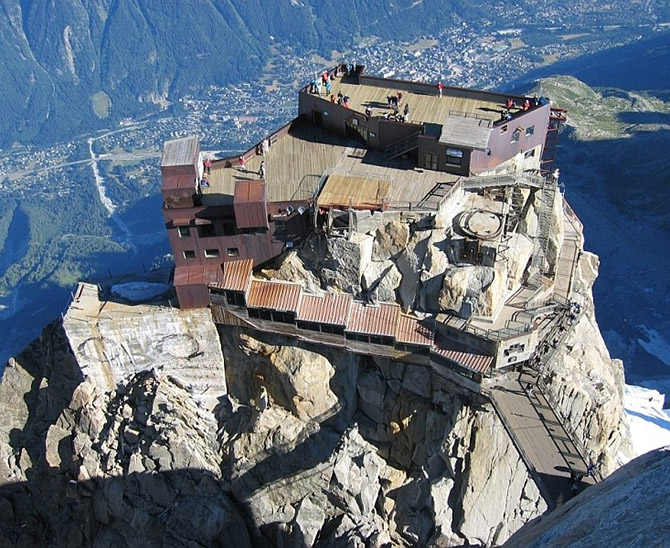 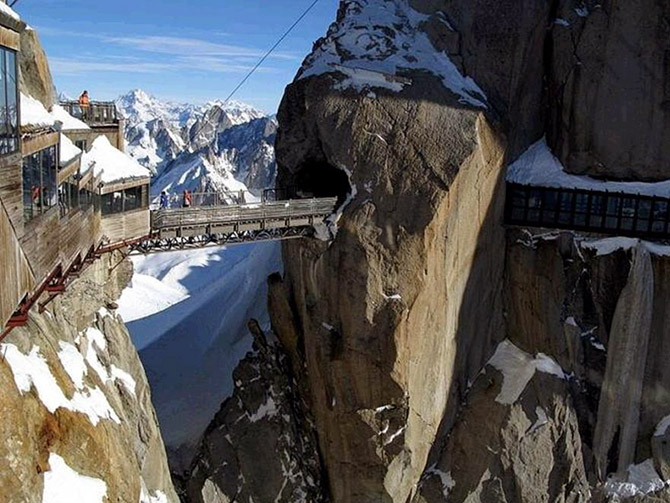 Two photos of architecture on the Aiguille du Midi in Chamonix, France; uncredited; found via Google Image Search. Two photos of architecture on the Aiguille du Midi in Chamonix, France; uncredited; found via Google Image Search.
So, here, in the Eastern Sierra, you can just say, Jed Clampett-style, eh, my crampons are over here, my ice axe is here, and, as long as my hiking partner isn’t within five feet of me, well—hook, swing—who cares? But when people start getting into a packed tram system in Chamonix, and they’ve all got to scoot together, you really need to start thinking about how you protect all those sharp points. How do you make sure no one’s exposed to those? You’ve got to know where those are.
Those differences are where I think a lot of the challenges are. It’s not necessarily intuitive that something that’s highly successful in one region will automatically have traction in another. Creating a globalized product in a highly specialized market can be very challenging and, oftentimes, there has to be a tolerance. You either have to have tolerance for a broader product assortment to meet regional needs, or you have to accept the fact that you may have a product that’s not specialized enough to hit the local super-user, because you’ve traded off specificity for an ambiguity that will reach more people.
Nicola Twilley: It seems to me that, although in your work you’re responding to the user, the user is also responding to the landscape—so, in effect, you’re responding to the landscape, too. When you look at a landscape, do you more typically see it in terms of what sort of activities you might do there, or are you looking at the landscape from the perspective of the gear you might need?
McGuire: In terms of gear, you do see the differences. I mean, take the west coast of the United States. The climbing conditions for a 40-liter pack in the North Cascades involve a much wetter environment, with much wetter snow and a more volatile climate all around, as far as sudden changes in weather go. But, here in the Eastern Sierra, you can probably plan on the fact that it’s not going to get any precipitation for the next 90 days. You don’t really have to think about bringing a ton of rain gear with you, because we just don’t get storms that show up out of nowhere or weather patterns that suddenly convert. That nuance in meteorological conditions will change what the customer’s wearing, which will change how their pack fits, which will change what they’re carrying, which will change how they store things inside the pack, because of what comes on and off and what they need access to. All those things come into effect.
Then you have geographic nuances—the way the different physical characteristics of the environment that you’re in are going to damage the pack. For example, if you are in a volcanic area, where you’re doing a lot of chimneying, you’re going to end up with a high abrasion area. The impacts of a granite environment and a lot of scree will have a different impact on gear than someone in a classic glacier environment.
So there are geologic elements and there are meteorological elements—and both have an impact on the product itself and an impact on what the user does there. The gear you need in a landscape and the activities you are going to do in that landscape are always going to feed into one another.
Twilley: So you can’t optimize a technical pack for the Eastern Sierra and for climbing in Washington State simultaneously, right? That wouldn’t be the same pack?
McGuire: True. All design at some point is a compromise. If you use vehicles as an analogy, the SUV is the ultimate compromise. It doesn’t really carry everything and it doesn’t drive like a sports car, but it’s still managed to fulfill this niche for people. It does enough things pretty well that it allows them to find their solution in one product. That’s an elusive role for packs. It’s why people who end up being pretty active rarely own one pack—they own two, three, or four of different literages, different weights, different carrying capacities, and different materials.
 An early U.S. Geological Survey field camp; photo courtesy of the USGS/U.S. Department of the Interior. An early U.S. Geological Survey field camp; photo courtesy of the USGS/U.S. Department of the Interior.
Manaugh: This is a fairly silly question, but I’m curious if, on a day where you have a lot of free time—you’re lying in a hammock in the mountains somewhere—you ever find yourself thinking that you could design a pack that would be absolutely perfect, but only for a very, very specific place. It would be the ultimate pack for a particular trail in Arizona—but for that trail only. It would be useless in Utah or on a trail in the Alps. And maybe it would cost $5,000—but it’s the perfect pack. Do you have dream gear like that?
McGuire: [laughs, pauses] At the end of the day, that’s what every gear head does. Not just the pack—they’re on the quest for the perfect kit. Unfortunately, what happens is that a large factor in enjoying the outdoor environment is wanderlust. As soon as your kit is perfect in one place, not only does the gear itself change over time or through use, but, usually, your reaction is, “Great! Now that I’ve experienced this, let me go to this other place…” And all of your metrics have been thrown off. You start building the perfect kit all over again. So, as soon as that’s obtainable, your own interest level changes, and it goes away.
Of course, I’m not actually a designer, in that I don’t really put pen to paper. I work on strategy and process, with people who do the pen-to-paper side of things—people who are highly creative and sometimes even have an arts background.
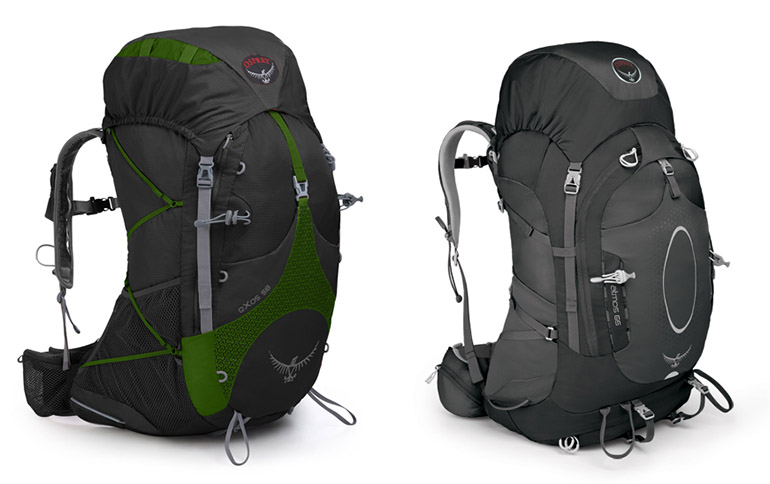 Courtesy Osprey Packs. Courtesy Osprey Packs.
One of the best examples of that kind of designer, and one of the people I admire the most in this space, is Mike Pfotenhauer, who’s the owner and designer of Osprey Packs. Mike is classically trained as a sculptor so, when you look at Mike’s pack design, there’s an aesthetic to his product that speaks to his ability as a sculptor. It’s very rare that you see straight lines. I’m convinced that if Mike could get someone to weave for him a curved webbing, his packs would all have curved webbing on them. He wants things to have this organic flow, which means there’s a signature to his packs, because he’s only worked on one brand as an owner and designer for his entire career.
 Courtesy Osprey Packs. Courtesy Osprey Packs.
But, when you look at the actual function of his designs, he’s a real user. He’s a backpacker. He doesn’t let his aesthetic override the fact that, as a user, he knows his end product has to work. Case in point: take the webbing. At the end of the day, something needs to be able to pull and compress. If the pieces of webbing that are the most effective at doing that require straight lines to pull, then he knows the pack’s aesthetic needs to give way to the fact that there’s a functional need calling for something different.
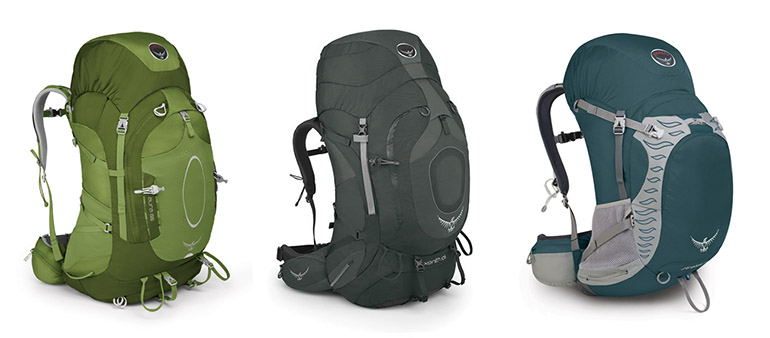 Courtesy Osprey Packs. Courtesy Osprey Packs.
Twilley: Given the importance of the user and the landscape, can you talk a little about how this gear is tested? Are there labs filled with simulated environments where packs are repeatedly rubbed against things, or sprayed with water and then flash-frozen to see what happens?
McGuire: There are three legitimate forms of testing. There’s the ASTM/EN, with the ASTM being the American Standard Testing Method and EN being the European Norm. These are scientific methodologies around proving whether something’s working in the right way. Those are usually at an item level. Then, there are ASTM things around complete packages like insulation warmth ratings for sleeping bags. There are rules around how to properly gauge the square footage and volume of a tent or the volume of the inside of a pack. So these are metrics that can be tested.
On the testing from a durability standpoint, oftentimes it’s specific devices that measure individual materials.
Twilley: Oh, so it’s not the complete pack. You just test a particular buckle, for example.
McGuire: Yeah. You might pull-test the buckle to make sure it can survive a 300-pound pull test. You might take a piece of material and put it on a Taber machine and see how many cycles it takes until the machine rubs a hole through it to see what the material’s abrasion durability is. Or you might do a tensile tear strength test to see how a tear would propagate in a rip-stop and how functional the rip-stop is.
These are functional tests that are relatively close to reality, but then there are also reality tests. The classic example of that is a lot of factories and companies will have access to things like very, very large commercial dryers; somebody has taken the time to open them up and bolt 2x4s and climbing holds and all kinds of stuff to the inside of the dryer. Then you throw a pack or a piece of luggage onto it, turn the dryer on, and let it just beat the daylights out of something till you see where your failures are.
Or you’ll have jerk tests on handles, where you’ll have a weight that—over and over again—will simulate the grabbing of a shoulder strap with a 60-pound pack and throwing it over your shoulder. What does that do to that seam? You’ll simulate it over and over again, and you’ll see, as you grab the shoulder strap and yank on it, if you yank a little this way or you yank a little that way, you end up putting different seam stresses on each place.
These sorts of reality-based testing devices are, oftentimes, custom manufactured. They’re not necessarily scientific. They’ll run through the cycles so that you see where there need to be improvements, but there’s not really a standardized test to measure it against.
But, still, today, in this industry, nothing beats human use.
Twilley: You mean field-testing?
McGuire: Product failures in this space are rarely attributable only to one thing. It’s almost always systematic. For instance, the shoulder strap didn’t fail because it was getting pulled up and down; the shoulder strap failed because of the way it was stitched, and then the way it was worn by the user, which created a spot where it sat on the shoulder blade, and that wore the stitching down over the course of a 600-mile trip, which then exposed the motion to a failure. An abrasion test on its own or a jerk test on its own wouldn’t expose that, but, in real world use, those two things combined expose a weakness. This is where human testing really is the quintessential component to make sure things work right.
This is also why so many people in design—in fact, every single person I know who was an inventor of an outdoor product in the 50s and 60s, during the real heyday of our industry—came into prominence not because they were designers. They were users who, by necessity, turned to design to solve a problem.
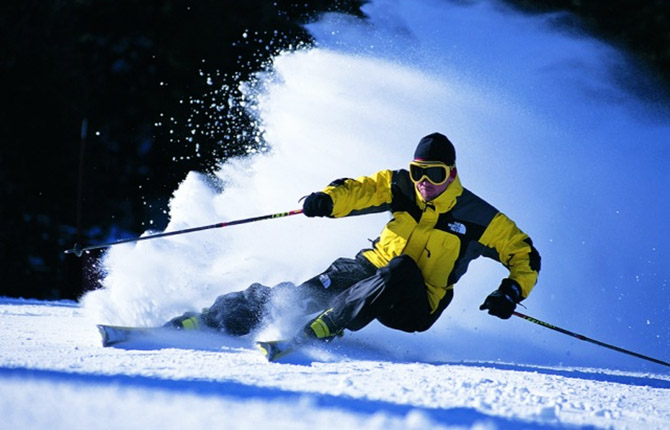 Image courtesy of Skipedia. Image courtesy of Skipedia.
This is how Scot Schmidt created the original Steep Tech gear for North Face. Scot didn’t want to be a clothing designer—at least, from everything I heard from him. Scot just wanted to be a skier who didn’t have to deal with duct taping his knees and shoulders because he was skiing in such horrendous conditions and he kept tearing the fabric.
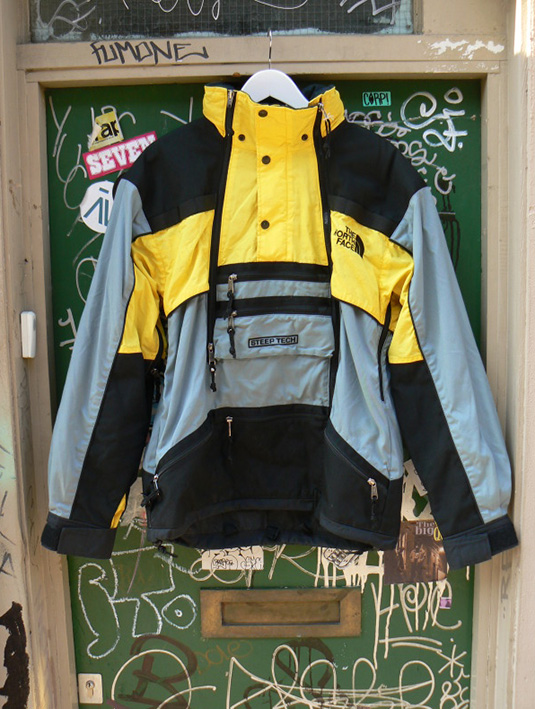 The original North Face Mountain Light jacket with its "iconic black shoulder"; photo courtesy ZONE7STYLE. The original North Face Mountain Light jacket with its "iconic black shoulder"; photo courtesy ZONE7STYLE.
The iconic black shoulder of the original North Face Mountain Light jacket came about not because someone thought, “Wow, straight lines and bold blocking is going to look awesome.” It came about because someone said, “I need a super-durable material because, when I throw my skis over my shoulder to hike up this ridge, the straight skis of the 1970s and 80s rub a hole through my jacket”—and the only thing available at the time was a 1680 ballistic nylon that only came in black because it was for the military.
You end up with an iconic design that was never intended to be an iconic design. It just happened that way because of a specific need, and it evolved to become an icon.
 Photo courtesy The North Face. Photo courtesy The North Face.
Twilley: Are there landscapes that gear innovation has opened up, in a way? Obviously, there are extreme landscapes, like Mt. Everest or Antarctica, where the right gear can be the difference between making it or not, but are other types of landscapes now opening up through innovations in outdoors gear?
McGuire: For sure. I think ever since people started pushing the limits of where they could survive, the types of landscapes available to people have changed. There are the extremes, like you mention, of being up in the Himalayas—up at high altitude—where gear has had an absolutely huge impact. But I would say that one of the challenges in our industry has actually been that, for the most part, for better or worse, most of the impacts on design from extreme environments happened more than a decade ago.
What’s happening today, I think, that’s now driving some of the greatest innovation aren’t the extremes of the environment, but what people are trying to do in that environment on either end. It’s the book-ends of either extreme. In other words, design is being driven now by people who are going much farther, much faster, and much harder than they ever did before.
Take the idea of building a product for hiking the Pacific Crest Trail—which is 2,400 miles. Typically, that would take four to six months—and, in 1970 or 1980, that was a pretty extreme environment. Now, that environment hasn’t really changed—there’s global warming, of course, so there have been changes in the glaciers and so on—but, effectively, that trail is the same as it was for the past forty or fifty years. What has changed now is that people are coming in and saying: “I want to do the entire Pacific Crest Trail, and I want to do it in ninety days. Instead of doing eight to ten miles a day, I want to do twenty-five or thirty miles a day.” In order to do that, people who were comfortable with carrying a 60-pound pack on the trip are now saying that there’s no way they’d go out there with more than 30 pounds. In fact, on the far end of that, people are saying they should be perfectly comfortable, and fully safe and functional, with only a 15-pound pack. Put all that together, and that necessitates a new kind of design.
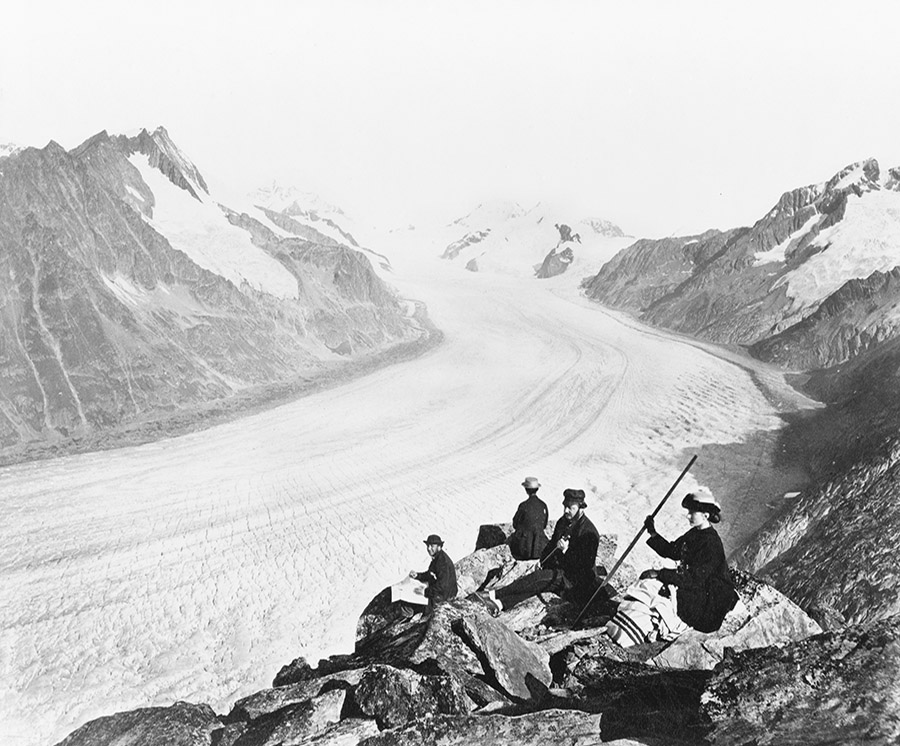 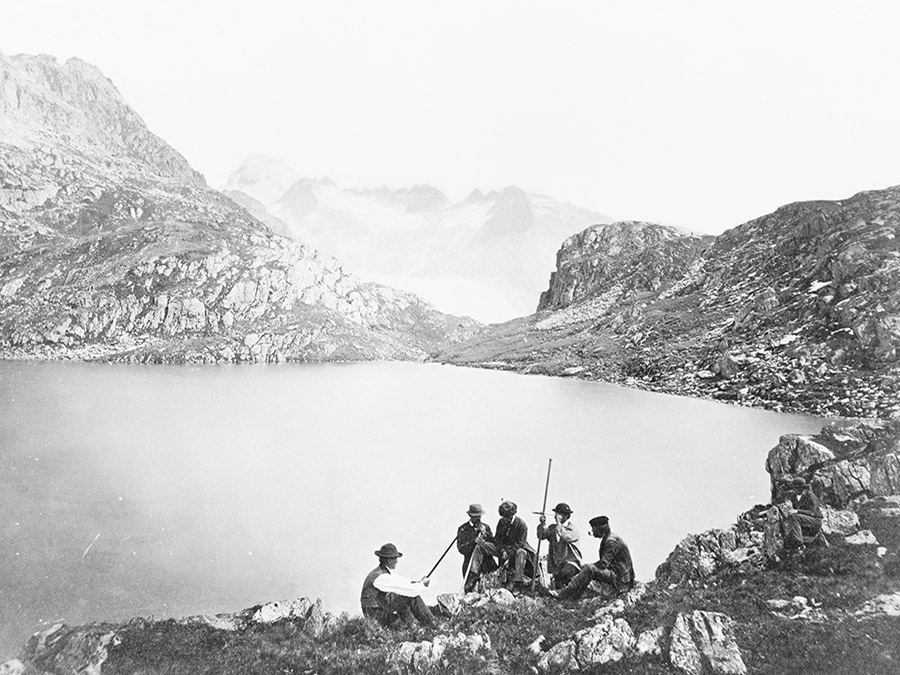 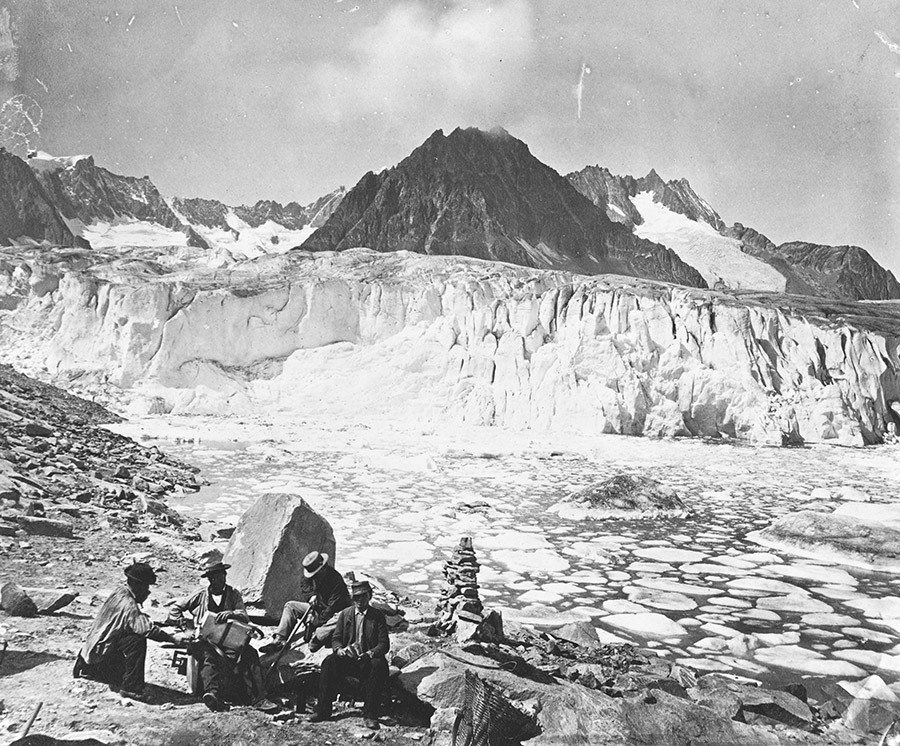 "Aletsch Glacier"; "Lac des Morts, Grimsell"; and"Aletsch Glacier, Eggischorn." All photos taken between 1860 and 1890. Courtesy of the U.S. Library of Congress Prints and Photographs Division. "Aletsch Glacier"; "Lac des Morts, Grimsell"; and"Aletsch Glacier, Eggischorn." All photos taken between 1860 and 1890. Courtesy of the U.S. Library of Congress Prints and Photographs Division.
But there’s also the other extreme. We have a society that is spending less and less time in the outdoors. What we’re finding, on the other end, is that the goal is to just make sure the approachability of the outdoors is simple enough, and convenient enough, and affordable enough, that, when people are trading a weekend in front of their Wii for a weekend taking their family camping on the side of a river, that it’s not intimidating. It’s not scary. For instance, how do you design a tent for someone who’s never set up a tent before, or who thinks a tent is so expensive that it’s a barrier to entry? A tent that’s not so complex that I can’t even imagine using it? Or a tent that’s not so small that I can’t stand up and change my clothes? What does that look like?
So you have these very divergent activities, these very different spaces, but, in each one, you have people who basically need something—they need a piece of gear or equipment—that can allow them to have this experience. That’s where I think most of the innovations have come from in the last decade. It’s not the middle ground. It’s these extreme fringes on either side.
Manaugh: Do you find, ironically, that the guy who wants to be home playing Wii all day in the suburbs is actually the more challenging design client?
McGuire: Well, let me back up a bit. If you go to a company like Procter & Gamble, for example, you find people there who are working as industrial designers, and they’re trying to think like a customer who they just might not be. But, in this industry, you have people who are really just trying to solve their own problems, in their own tinkering way.
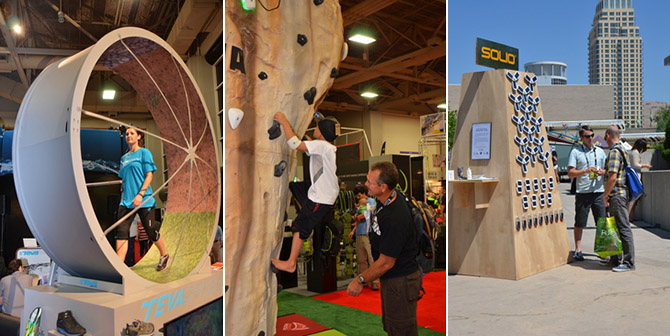 Photos courtesy of the Outdoor Retailer show. Photos courtesy of the Outdoor Retailer show.
The Outdoor Retailer trade show is a very unique environment, in that regard. It’s like a tribe. You walk into that outdoor retailer environment and, if you’re in the outdoor industry, you can see straightaway who’s there and who’s not there—meaning, who’s part of the tribe and who’s a visitor. It’s a group of a lot of the same people, over decades now, doing a lot of the same things. You might see different companies and different brands over time, but what you don’t see is a lot of people from outside of that space showing up there. If you’re an outsider and you show up—if you’re trying to pose like you’re there, and trying to sell into that space—that group smells your inauthenticity right away. But, now, this tribe mentality is starting to recognize that the future of the industry is outside of our own doors. In fact, not enough people are finding their way into the tribe on their own and we have to bring in more people.
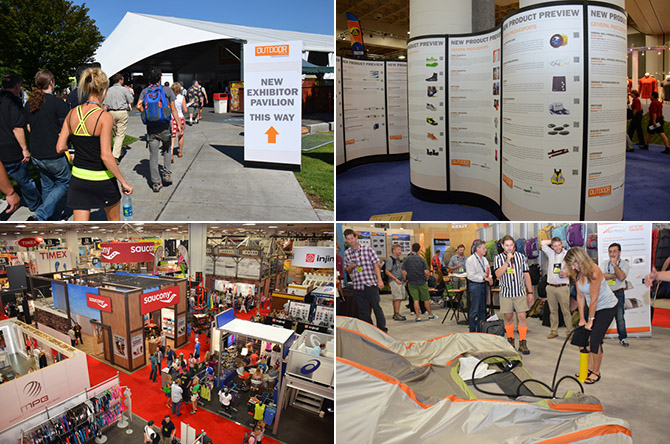 Photos courtesy of the Outdoor Retailer show. Photos courtesy of the Outdoor Retailer show.
So the industry itself has been wrestling with this. How do we go out and approach someone? I’ll use an analogy. In the industry, there have been three rings of people: there’s your hardcore ring of people who are absolute purists: “I make it all myself. And I’m so badass, no one even knows where I go.”
They’re almost elitist in their pursuit of their sport. But then you have another side, which is a group of people who like the outdoors, but they’ve recognized that there’s commercial value there. They are mostly driven by the business side of it. They’re people who want to work in the outdoor company sector because they like the idea of going to work in a T-shirt and jeans, versus wearing a suit, and their skills lend themselves to this space, but you also kind of know that a person like that isn’t really from here because their core motivation is: “Wow, we can make money off of this!”
So the ex-suits don’t get the hardcores, and the hardcores resent the fact that all these ex-suits are showing up. Then there’s this tiny group in the middle who are interested in the business side, but they also come from the hardcore side at one point—and, what’s interesting is that all of these people in this group of three circles in the industry right now are wondering: “Who’s going to come in from outside our three circles? Who’s going to drive the business going forward? Who are those people?”
 Photos courtesy of the Outdoor Retailer show. Photos courtesy of the Outdoor Retailer show.
There were some good industry numbers that came out recently where, for the first time, we’re seeing the number of young people getting exposed to the outdoors is on a slight uptick. I would say it’s encouraging news. It’s not good news, because we still have a long way to go. But, from a design standpoint in the industry, that’s something that appeals both to the suits—“Wow, new customers! More money!”—and also that center group, along with the old hardcores, who love seeing the interest and the energy grow. They all see that, from a culture standpoint, we need this: the stronger our tribe is—the more people who come into it—the better it’s all going to be.
But I have a love/hate relationship with some of the solutions that have come up in the past few years. Here, in the Eastern Sierras, we have a pretty robust program where you can get on the phone in Los Angeles and call a company that will deliver a camping trailer to a campground here for you. You drive up in your little economy car from the city, and you pull into a campground, and the there’s this 26-foot trailer sitting there waiting for you, with all the comforts of home. It’s got a mattress; it’s got running water; it’s got a toilet; the refrigerator is eve pre-stocked. The stoves are there. There’s propane in the tanks. It’s like a pop-up hotel.
The “love” part of me is that more people are now actually making the trip. It’s like a gateway drug. Somebody who might not have got in their car is at least opening their door at 6:00 in the morning and smelling trees and not being in a parking lot at a hotel somewhere. So it’s a start.
The difference, though—the “hate” part of me—is that there’s nothing like being out there in the dark, putting a tent up, finding a site. You know, maybe I’m a little bit of a sadomasochist in this regard. But, for me, when you’re in the outdoors, tripping over the picnic table and trying to figure out where the guylines go, and dropping stakes and wondering if you remembered to put them all in… Not that I want to see people suffer! But part of it is actually about the dirt under the fingernails—it’s that sharp rock under the tent that keeps you awake at night.
But, as long as people are making the trip, and, from a design standpoint, as long as we’re making a product that eases that transition for people as much as possible…
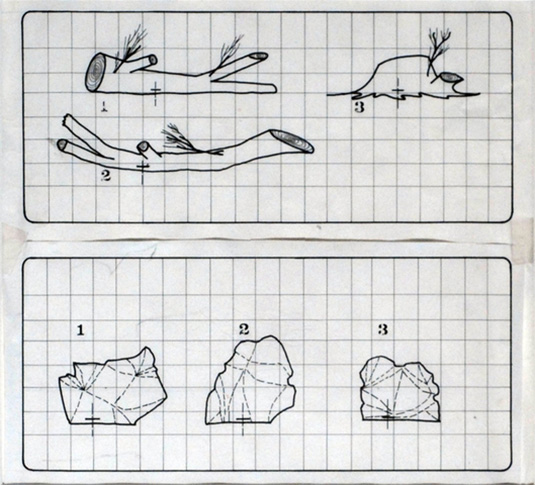 The LogPlug and RokPlug projects by Archigram, courtesy of the Archigram Archival Project at the University of Westminster. The LogPlug and RokPlug projects by Archigram, courtesy of the Archigram Archival Project at the University of Westminster.
Manaugh: It’s funny, your trailer example actually reminded me of this group of architectural designers in England in the 1960s/early 70s called Archigram. They were somewhere between science fiction and Woodstock. They had this one series of designs—and it was all totally speculative—for fake logs with electrical outlets that could be put out in the woods somewhere, and even fake rocks that could act as speakers, and so on.
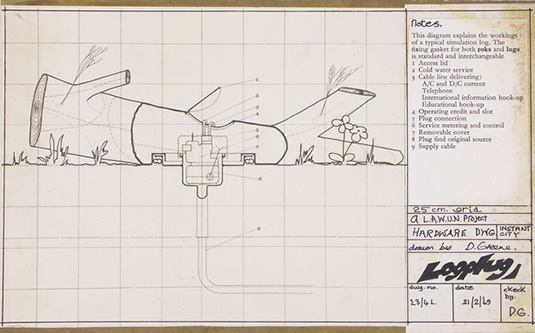 The LogPlug and RokPlug projects by Archigram, courtesy of the Archigram Archival Project at the University of Westminster. The LogPlug and RokPlug projects by Archigram, courtesy of the Archigram Archival Project at the University of Westminster.
But the funny thing is that the intention of the project was to get more people in 1960s England out of their middle-class houses and into the wilderness, to experience a non-urban environment. Of course, though, the perhaps unanticipated side effect of a proposal like that is that they were actually just extending the city out into the woods, letting you take all these ridiculous things, like TVs and toasters, in the great outdoors with you, things that you don’t ever really need in that environment in the first place.
 The LogPlug and RokPlug projects by Archigram, courtesy of the Archigram Archival Project at the University of Westminster. The LogPlug and RokPlug projects by Archigram, courtesy of the Archigram Archival Project at the University of Westminster.
In other words, it seems like an almost impossibly thin line between enticing people to go out into a new environment versus simply taking their ubiquitous home environment and infecting someplace new with it. The next thing you know, the woods are just like London and the Eastern Sierra are just like Los Angeles.
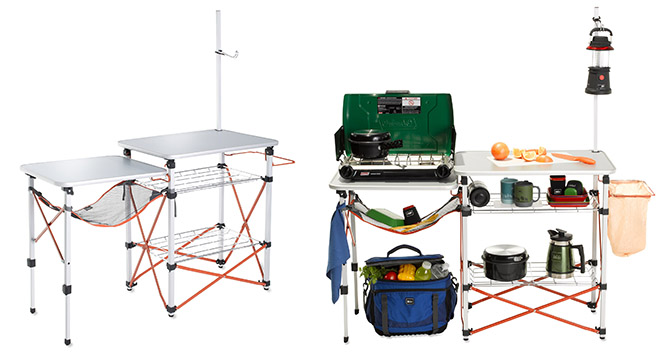 REI's portable, pop-up, outdoor Camp Kitchen. Are outdoor equipment manufacturers the true inheritors of Archigram's speculative design mantle? REI's portable, pop-up, outdoor Camp Kitchen. Are outdoor equipment manufacturers the true inheritors of Archigram's speculative design mantle?
In any case, I wanted to return to something you said earlier about ballistic nylon materials that had originally been developed by the military. Are you still finding materials and technical innovations coming out of the military that can be “civilianized,” so to speak, for use by outdoors enthusiasts? For instance, I recently read that the military has developed silent Velcro, which seems like it could be useful for backpackers.
McGuire: Definitely, yes. On the military side of things, what’s different now, is that, except on very rare occasions, people today are not humping huge loads over long distances to fight wars. Soldiers are now incredibly mobile. They’re vehicle-based; they move in; they move out; they carry just what they need; they get the job done; and they’re gone. We have a lot of people coming back from wars today—and I’m not at all taking away from what they’re doing—but their war experience is unlike even just a few generations ago, where you put your pack on and everything you needed was in your pack and you were gone out in the wilderness somewhere for a year. We increasingly have soldiers who get in a Humvee, go out for a day, maybe two days, and then they’re back at base.
 "New York Central Issue Facility Strives to Get National Guard Troops Latest Gear." Image and caption courtesy of the U.S. Army. "New York Central Issue Facility Strives to Get National Guard Troops Latest Gear." Image and caption courtesy of the U.S. Army.
What I think we’re seeing, culturally, is a lot like this. The patience for long-term adventures is waning. People want to go out and have an experience. They want it to be quick. They want it to be impactful. They want it to be memorable. And, to be honest, they want it to be easy. It’s the “I want to see Europe in five days and here are all my pictures” thing. It’s speed and efficiency. Well, one area where the military is lending some benefit is that they’re developing a lot of specialized gear for these in quick/out quick, intense experiences. You’re seeing things like the MOLLE system—what is it, Modular, Lightweight, Load-carrying Equipment?—and that modularity is seeping out of the military to influence outdoor gear design, where you’re able to have a base system that can increase or decrease in size, depending on the specifics of your day and what you’re going to go out and do. These are influences that that are now starting to show up.
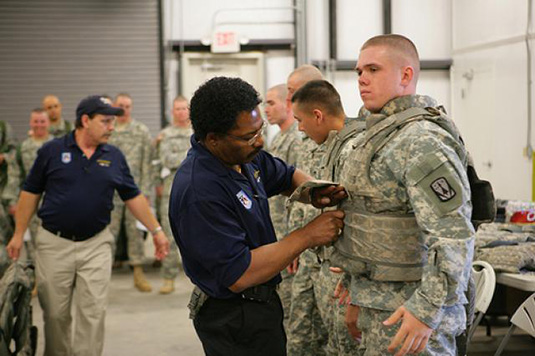 "The Army is able to swiftly deploy soldiers where they're needed and part of that is ensuring soldiers are properly equipped. The materials they need-they need fast, and that's where a rapid fielding initiative team comes in." Image and caption courtesy of the U.S. Army. "The Army is able to swiftly deploy soldiers where they're needed and part of that is ensuring soldiers are properly equipped. The materials they need-they need fast, and that's where a rapid fielding initiative team comes in." Image and caption courtesy of the U.S. Army.
And there are some strong crossovers, in things like hydration, that are now becoming much more ubiquitous. We aren’t seeing that crossover quite as influentially as the original A-frame tents, or the development of sleeping bags coming out of World War I and World War II, but we’re certainly still seeing it. But I would say that the most significant recent impact are things like GPS—highly specialized technical solutions that make things work much better and much easier, and that don’t take up a lot of space.
GPS is military-based, and the ability to know where you are, where you’re going, and how to get back, without having to rely on map knowledge, has opened up all kinds of confidence for people to get into new places. Personally, I love using a GPS, but I still think you ought to know which way north is and how to read a map—because batteries die.
We’re also still seeing new materials come out of the military, like super-lightweight parachute fabrics that are allowing people to have highly tear-resistant, lighter-weight equipment. And, even with helmets, the foams used in lighter-weight, highly protective helmets are changing, mostly as a result of IEDs.
 Combat helmets with sensors attached are part of "the next generation of protective equipment" for the U.S. Army. Image courtesy of the U.S. Army. Combat helmets with sensors attached are part of "the next generation of protective equipment" for the U.S. Army. Image courtesy of the U.S. Army.
So, yes, we are seeing elements of the military trickle into outdoor gear. I just think that, with the needs of the military being what they are today, and the way that wars are being fought now, it just happens to serendipitously fall in line with a cultural desire for short, fast, light outdoors experiences—you’re done and you’re back. It is a bizarre overlap, but you’d be hard-pressed to say it’s attributable to one or the other.
Manaugh: To build on that question of cultural shifts, when you said t
Wednesday, March 06. 2013
Via The New York Times
-----
A City Prepares for a Warm Long-Term Forecast
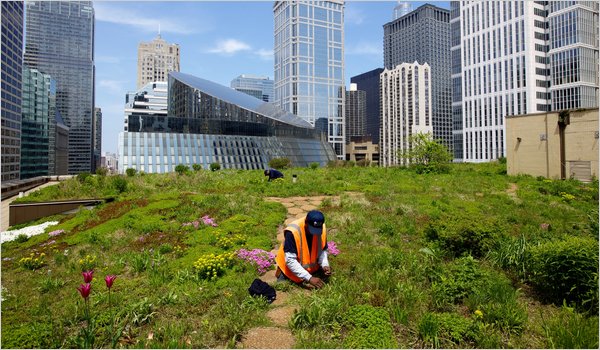
CHICAGO — The Windy City is preparing for a heat wave — a permanent one.
Climate scientists have told city planners that based on current trends, Chicago will feel more like Baton Rouge than a Northern metropolis before the end of this century.
So, Chicago is getting ready for a wetter, steamier future. Public alleyways are being repaved with materials that are permeable to water. The white oak, the state tree of Illinois, has been banned from city planting lists, and swamp oaks and sweet gum trees from the South have been given new priority. Thermal radar is being used to map the city’s hottest spots, which are then targets for pavement removal and the addition of vegetation to roofs. And air-conditioners are being considered for all 750 public schools, which until now have been heated but rarely cooled.
“Cities adapt or they go away,” said Aaron N. Durnbaugh, deputy commissioner of Chicago’s Department of Environment. “Climate change is happening in both real and dramatic ways, but also in slow, pervasive ways. We can handle it, but we do need to acknowledge it. We are on a 50-year cycle, but we need to get going.”
Across America and in Congress, the very existence of climate change continues to be challenged — especially by conservatives. The skeptics are supported by constituents wary of science and concerned about the economic impacts of stronger regulation. Yet even as the debate rages on, city and state planners are beginning to prepare.
The precise consequences of the increase of man-made greenhouse gases in the atmosphere are hard to determine, but scientists are predicting significant sea level rise; more extreme weather events like storms, tornadoes and blizzards; and, of course, much more heat. New York City, which is doing its own adaptation planning, is worried about flooding from the rising ocean. The Navy has a task force on climate change that says it should be preparing to police the equivalent of an extra sea as the Arctic ice melts.
Some of these events will occur in the near-enough term that local governments are under pressure to act. Insurance companies are applying pressure in high-risk areas, essentially saying adapt or pay higher premiums — especially in urban and commercial areas.
The reinsurance giant Swiss Re, for example, has said that if the shore communities of four Gulf Coast states choose not to implement adaptation strategies, they could see annual climate-change related damages jump 65 percent a year to $23 billion by 2030.
“Society needs to reduce its vulnerability to climate risks, and as long as they remain manageable, they remain insurable, which is our interest as well,” said Mark D. Way, head of Swiss Re’s sustainable development for the Americas.
Melissa Stults, the climate director for ICLEI USA, an association of local governments, said that many of the administrations she was dealing with were following a strategy of “discreetly integrating preparedness into traditional planning efforts.”
Second City First
Chicago is often called the Second City, but it is way out in front of most in terms of adaptation.
The effort began in 2006, under the mayor at the time, Richard M. Daley. He said he was inspired in part by the Kyoto international treaty for reducing carbon emissions, which took effect in 2005, and also by an aspiration to raise Chicago’s profile as an environmentally friendly town.
As a first step, the city wanted to model how global warming might play out locally. Foundations, eager to get local governments moving, put up some money.
“There was real assumption that Chicago could be a model for other places,” said Adele Simmons, president of Global Philanthropy Partnership, a nonprofit group based in Chicago that helped bring in $700,000 at the early stages.
Climatologists took into account a century’s worth of historical observations of daily temperatures and precipitation from 15 Chicago-area weather stations as well as the effect of Lake Michigan in moderating extreme heat and cold to come up with a range of possibilities based on a higher and lower range of worldwide carbon emissions.
The forecasts, while not out of line with global predictions, shocked city planners.
If world carbon emissions continued apace, the scientists said, Chicago would have summers like the Deep South, with as many as 72 days over 90 degrees before the end of the century. For most of the 20th century, the city averaged fewer than 15.
By 2070, Chicago could expect 35 percent more precipitation in winter and spring, but 20 percent less in summer and fall. By then, the conditions would have changed enough to make the area’s plant hardiness zone akin to Birmingham, Ala.
But what would that mean in real-life consequences? A private risk assessment firm was hired, and the resulting report read like an urban disaster film minus Godzilla.
The city could see heat-related deaths reaching 1,200 a year. The increasing occurrences of freezes and thaws (the root of potholes) would cause billions of dollars’ worth of deterioration to building facades, bridges and roads. Termites, never previously able to withstand Chicago’s winters, would start gorging on wooden frames.
Armed with the forecasts, the city prioritized which adaptations would save the most money and would be the most feasible in the light of tight budgets and public skepticism.
“We put each of the priorities through a lens of political, economic and technical,” said Suzanne Malec-McKenna, the commissioner of Chicago’s Department of Environment. “What is it, if you will, that will pass the laugh test?”
Among the ideas rejected, Ms. Malec-McKenna said, were plans to immediately shut down local coal-powered energy plants — too much cost for too little payback.
For actions the city felt were necessary but not affordable, it got help again from a local institution, the Civic Consulting Alliance, a nonprofit organization that builds pro bono teams of business experts. In this case, the alliance convinced consulting firms to donate $14 million worth of hours to projects like designing an electric car infrastructure and planning how to move the city toward zero waste.
Mr. Daley embraced the project. He convened 20 city departments in 2010 and told them to weigh their planning dollars against the changes experts were predicting. The department heads continued to meet quarterly, and members of Mayor Rahm Emanuel’s administration have said he is committed to moving the goals of the plan forward, albeit with an added emphasis on “projects that accelerate jobs and economic development.”
Updating Infrastructure
Much of Chicago’s adaptation work is about transforming paved spaces. “Cities are hard spaces that trap water and heat,” said Janet L. Attarian, a director of streetscapes at the city’s Department of Transportation. “Alleys and streets account for 25 percent of groundcover, and closer to 40 percent when parking lots are included.”
The city’s 13,000 concrete alleyways were originally built without drainage and are a nightmare every time it rains. Storm water pours off the hard surfaces and routinely floods basements and renders low-lying roads and underpasses unusable.
To make matters worse, many of the pipes that handle storm overflow also handle raw sewage. After a very heavy rain, if overflow pipes become congested, sewage backs up into basements or is released with the rainwater into the Chicago River — an emergency response that has attracted the scrutiny of the Environmental Protection Agency.
As the region warms, Chicago is expecting more frequent and extreme storms. In the last three years, the city has had two intense storms classified as 100-year events.
So the work planned for a six-point intersection on the South Side with flooding and other issues is a prototype. The sidewalk in front of the high school on Cermak Road has been widened to include planting areas that are lower than the street surface. This not only encourages more pedestrian traffic, but also provides shade and landscaping. These will be filled with drought-resistant plants like butterfly weed and spartina grasses that sponge up excess water and help filter pollutants like de-icing salts. In some places, unabsorbed water will seep into storage tanks beneath the streets so it can be used later for watering plants or in new decorative fountains in front of the high school.
The bike lanes and parking spaces being added along the street are covered with permeable pavers, a weave of pavement that allows 80 percent of rainwater to filter through it to the ground below. Already 150 alleyways have been remade in this way.
The light-reflecting pavement is Chicago’s own mix and includes recycled tires. Rubbery additives help the asphalt expand in heat without buckling and to contract without cracking.
The new streets bring new challenges, of course. The permeable pavers have to be specially cleaned or they eventually become clogged with silt and lose effectiveness.
Still, the new construction is no more expensive than traditional costs, Ms. Attarian said. Transforming one alleyway costs about $150,000. But now, she said, “We can put a fire hose on it full blast and the water seeps right in.”
Reconsidering the Trees
Awareness of climate change has filled Chicago city planners with deep concern for the trees.
Not only are they beautiful, said Ms. Malec-McKenna, herself trained as a horticulturalist, but their shade also provides immediate relief to urban heat islands. Trees improve air quality by absorbing carbon dioxide, and their leaves can keep 20 percent of an average rain from hitting the pavement.
Chicago spends over $10 million a year planting roughly 2,200 trees. From 1991 to 2008, the city added so many that officials estimate tree cover increased to 17.6 percent from 11 percent. The goal is to exceed 23 percent this decade.
The problem is that for trees to reach their expected lifespan — up to 90 years — they have to be able to endure hotter conditions. Chicago has already changed from one growing zone to another in the last 30 years, and it expects to change several times again by 2070.
Knowing this, planners asked experts at the city’s botanical garden and Morton Arboretum to evaluate their planting list. They were told to remove six of the most common tree species.
Off came the ash trees that account for 17 percent of Chicago tree cover, or more than any other tree. Gone, too, are the enormous Norway maples, which provide the most amount of shade.
A warming climate will make them more susceptible to plagues like emerald ash disease. Already white oak, the state tree of Illinois, is on the decline and, like several species of conifer, is expected to be extinct from the region within decades.
So Chicago is turning to swamp white oaks and bald cypress. It is like the rest of adaptation strategy, Ms. Malec-McKenna explains: “A constant ongoing process to make sure we are as resilient as we can be in facing the future.”
Personal comment:
To be read in connection with this previous post about our warming world: One degree (Celsius) of separation, huge differences. As well as with this post by Pruned: Stormproofing Cities, as well as possibly with this one I posted a few month ago regarding the idea of inhabiting the hurricanes (pathways).
Via MIT Technology Review
-----
Belgium has plans for an artificial “energy atoll” to store excess wind power in the North Sea.

This illustration shows how the artificial island would use pumped hydro energy storage where water is pumped to a reservoir during off-peak times and released to a lower reservoir later to generate electricity.
Perhaps it’s not surprising that people from countries with experience holding back the sea see the potential of building an artificial island to store wind energy.
Belgian cabinet member, Johan Vande Lanotte, has introduced a planning proposal for a man-made atoll placed in the North Sea to store energy.
The idea is to place the island a few kilometers off shore near a wind farm, according to Vande Lanotte’s office. When the wind farm produces excess energy for the local electricity grid, such as off-peak times in the overnight hours, the island will store the energy and release it later during peak times.
It would use the oldest and most cost-effective bulk energy storage there is: pumped hydro. During off-peak times, power from the turbines would pump water up 15 meters to a reservoir. To generate electricity during peak times, the water is released to turn a generator, according to a representative.
The Belgian government doesn’t propose building the facility itself and would rely on private industry instead. But there is sufficient interest in energy storage that it should be part of planning exercises and weighed against other activities in the North Sea, the representative said. It would be placed three kilometers offshore and be 2.4 kilometers wide, according to a drawing provided by Vande Lanotte’s office.
The plan underscores some of the challenges associated with energy storage for the electricity grid. Pumped hydro, which contributes a significant portion of energy supply in certain countries, is by far the cheapest form of multi-hour energy storage. It costs about $100 per kilowatt-hour, a fraction of batteries, flywheels, and other methods, according to the Electricity Storage Association. (See a cost comparison chart here.) And grid storage is a considered critical to using intermittent solar and wind power more widely.
The idea of using an “energy atoll” may seen outlandish on the surface, but it’s really not, says Haresh Kamath, program manager for energy storage at the Electric Power Research Institute (EPRI). This approach, first proposed by a Dutch company, uses cheap materials—water and dirt. On the other hand, the engineering challenges of building in the ocean and technical issues, such as using salt water with a generator, are significant.
“It’s not totally crazy—it’s within the realm of reason. The question isn’t whether we can do it,” he says. “It’s whether it makes sense and that’s the thing that needs further studies and understanding.”
Thursday, February 07. 2013
Note: I'm again here joining two recent posts. First, what it could climatically and therefore spatially, geographically, energetically, socialy, ... mean, degree after degree to increase the average temperature of the Earth and second, an information map about our warming world...
It is an unsigned paper, so it certainly need to be cross-checked, which I haven't done (time, time...)! But I post it nevertheless as it points out some believable consequences, yet very dark. As many people say now, we don't have much time left to start acting, strong (7-10 years).
Via Berens Finance (!)
-----
A degree by degree explanation of what will happen when the earth warms
-
Even if greenhouse emissions stopped overnight the concentrations already in the atmosphere would still mean a global rise of between 0.5 and 1C. A shift of a single degree is barely perceptible to human skin, but it’s not human skin we’re talking about. It’s the planet; and an average increase of one degree across its entire surface means huge changes in climatic extremes.
Six thousand years ago, when the world was one degree warmer than it is now, the American agricultural heartland around Nebraska was desert. It suffered a short reprise during the dust- bowl years of the 1930s, when the topsoil blew away and hundreds of thousands of refugees trailed through the dust to an uncertain welcome further west. The effect of one-degree warming, therefore, requires no great feat of imagination.
“The western United States once again could suffer perennial droughts, far worse than the 1930s. Deserts will reappear particularly in Nebraska, but also in eastern Montana, Wyoming and Arizona, northern Texas and Oklahoma. As dust and sandstorms turn day into night across thousands of miles of former prairie, farmsteads, roads and even entire towns will be engulfed by sand.”
What’s bad for America will be worse for poorer countries closer to the equator. It has beencalculated that a one-degree increase would eliminate fresh water from a third of the world’s land surface by 2100. Again we have seen what this means. There was an incident in the summer of 2005: One tributary fell so low that miles of exposed riverbank dried out into sand dunes, with winds whipping up thick sandstorms. As desperate villagers looked out onto baking mud instead of flowing water, the army was drafted in to ferry precious drinking water up the river – by helicopter, since most of the river was too low to be navigable by boat. The river in question was not some small, insignificant trickle in Sussex. It was the Amazon.
While tropical lands teeter on the brink, the Arctic already may have passed the point of no return. Warming near the pole is much faster than the global average, with the result that Arctic icecaps and glaciers have lost 400 cubic kilometres of ice in 40 years. Permafrost – ground that has lain frozen for thousands of years – is dissolving into mud and lakes, destabilising whole areas as the ground collapses beneath buildings, roads and pipelines. As polar bears and Inuits are being pushed off the top of the planet, previous predictions are starting to look optimistic. Earlier snowmelt means more summer heat goes into the air and ground rather than into melting snow, raising temperatures in a positive feedback effect. More dark shrubs and forest on formerly bleak tundra means still more heat is absorbed by vegetation.
Out at sea the pace is even faster. Whilst snow-covered ice reflects more than 80% of the sun’s heat, the darker ocean absorbs up to 95% of solar radiation. Once sea ice begins to melt, in other words, the process becomes self-reinforcing. More ocean surface is revealed, absorbing solar heat, raising temperatures and making it unlikelier that ice will re-form next winter. The disappearance of 720,000 square kilometres of supposedly permanent ice in a single year testifies to the rapidity of planetary change. If you have ever wondered what it will feel like when the Earth crosses a tipping point, savour the moment.
Mountains, too, are starting to come apart. In the Alps, most ground above 3,000 metres is stabilised by permafrost. In the summer of 2003, however, the melt zone climbed right up to 4,600 metres, higher than the summit of the Matterhorn and nearly as high as Mont Blanc. With the glue of millennia melting away, rocks showered down and 50 climbers died. As temperatures go on edging upwards, it won’t just be mountaineers who flee. Whole towns and villages will be at risk. Some towns, like Pontresina in eastern Switzerland, have already begun building bulwarks against landslides.
At the opposite end of the scale, low-lying atoll countries such as the Maldives will be preparing for extinction as sea levels rise, and mainland coasts – in particular the eastern US and Gulf of Mexico, the Caribbean and Pacific islands and the Bay of Bengal – will be hit by stronger and stronger hurricanes as the water warms. Hurricane Katrina, which in 2005 hit New Orleans with the combined impacts of earthquake and flood, was a nightmare precursor of what the future holds.
Most striking of all was seeing how people behaved once the veneer of civilisation had been torn away. Most victims were poor and black, left to fend for themselves as the police either joined in the looting or deserted the area. Four days into the crisis, survivors were packed into the city’s Superdome, living next to overflowing toilets and rotting bodies as gangs of young men with guns seized the only food and water available. Perhaps the most memorable scene was a single military helicopter landing for just a few minutes, its crew flinging food parcels and water bottles out onto the ground before hurriedly taking off again as if from a war zone. In scenes more like a Third World refugee camp than an American urban centre, young men fought for the water as pregnant women and the elderly looked on with nothing. Don’t blame them for behaving like this, I thought. It’s what happens when people are desperate.
Chance of avoiding one degree of global warming: zero.
BETWEEN ONE AND TWO DEGREES OF WARMING
At this level, expected within 40 years, the hot European summer of 2003 will be the annual norm. Anything that could be called a heatwave thereafter will be of Saharan intensity. Even in average years, people will die of heat stress.
The first symptoms may be minor. A person will feel slightly nauseous, dizzy and irritable. It needn’t be an emergency: an hour or so lying down in a cooler area, sipping water, will cure it. But in Paris, August 2003, there were no cooler areas, especially for elderly people.
Once body temperature reaches 41C (104F) its thermoregulatory system begins to break down. Sweating ceases and breathing becomes shallow and rapid. The pulse quickens, and the victim may lapse into a coma. Unless drastic measures are taken to reduce the body’s core temperature, the brain is starved of oxygen and vital organs begin to fail. Death will be only minutes away unless the emergency services can quickly get the victim into intensive care.
These emergency services failed to save more than 10,000 French in the summer of 2003. Mortuaries ran out of space as hundreds of dead bodies were brought in each night. Across Europe as a whole, the heatwave is believed to have cost between 22,000 and 35,000 lives. Agriculture, too, was devastated. Farmers lost $12 billion worth of crops, and Portugal alone suffered $12 billion of forest-fire damage. The flows of the River Po in Italy, Rhine in Germany and Loire in France all shrank to historic lows. Barges ran aground, and there was not enough water for irrigation and hydroelectricity. Melt rates in the Alps, where some glaciers lost 10% of their mass, were not just a record – they doubled the previous record of 1998. According to the Hadley centre, more than half the European summers by 2040 will be hotter than this. Extreme summers will take a much heavier toll of human life, with body counts likely to reach hundreds of thousands. Crops will bake in the fields, and forests will die off and burn. Even so, the short-term effects may not be the worst:
From the beech forests of northern Europe to the evergreen oaks of the Mediterranean, plant growth across the whole landmass in 2003 slowed and then stopped. Instead of absorbing carbon dioxide, the stressed plants began to emit it. Around half a billion tonnes of carbon was added to the atmosphere from European plants, equivalent to a twelfth of global emissions from fossil fuels. This is a positive feedback of critical importance, because it suggests that, as temperatures rise, carbon emissions from forests and soils will also rise. If these land-based emissions are sustained over long periods, global warming could spiral out of control.
In the two-degree world, nobody will think of taking Mediterranean holidays. The movement of people from northern Europe to the Mediterranean is likely to reverse, switching eventually into a mass scramble as Saharan heatwaves sweep across the Med. People everywhere will think twice about moving to the coast. When temperatures were last between 1 and 2C higher than they are now, 125,000 years ago, sea levels were five or six metres higher too. All this “lost” water is in the polar ice that is now melting. Forecasters predict that the “tipping point” for Greenland won’t arrive until average temperatures have risen by 2.7C. The snag is that Greenland is warming much faster than the rest of the world – 2.2 times the global average. “Divide one figure by the other,” says Lynas, “and the result should ring alarm bells across the world. Greenland will tip into irreversible melt once global temperatures rise past a mere 1.2C. The ensuing sea-level ?rise will be far more than the half-metre that ?the IPCC has predicted for the end of the century. Scientists point out that sea levels at the end of the last ice age shot up by a metre every 20 years for four centuries, and that Greenland’s ice, in the words of one glaciologist, is now thinning like mad and flowing much faster than it ought to. Its biggest outflow glacier, Jakobshavn Isbrae, has thinned by 15 metres every year since 1997, and its speed of flow has doubled. At this rate the whole Greenland ice sheet would vanish within 140 years. Miami would disappear, as would most of Manhattan. Central London would be flooded. Bangkok, Bombay and Shanghai would lose most of their area. In all, half of humanity would have to move to higher ground.
Not only coastal communities will suffer. As mountains lose their glaciers, so people will lose their water supplies. The entire Indian subcontinent will be fighting for survival. As the glaciers disappear from all but the highest peaks, their runoff will cease to power the massive rivers that deliver vital freshwater to hundreds of millions. Water shortages and famine will be the result, destabilising the entire region. And this time the epicentre of the disaster won’t be India, Nepal or Bangladesh, but nuclear-armed Pakistan.
Everywhere, ecosystems will unravel as species either migrate or fall out of synch with each other. By the time global temperatures reach two degrees of warming in 2050, more than a third of all living species will face extinction.
Chance of avoiding two degrees of global warming: 93%, but only if emissions of greenhouse gases are reduced by 60% over the next 10 years.
BETWEEN TWO AND THREE DEGREES OF WARMING
Up to this point, assuming that governments have planned carefully and farmers have converted to more appropriate crops, not too many people outside subtropical Africa need have starved. Beyond two degrees, however, preventing mass starvation will be as easy as halting the cycles of the moon. First millions, then billions, of people will face an increasingly tough battle to survive.
To find anything comparable we have to go back to the Pliocene – last epoch of the Tertiary period, 3m years ago. There were no continental glaciers in the northern hemisphere (trees grew in the Arctic), and sea levels were 25 metres higher than today’s. In this kind of heat, the death of the Amazon is as inevitable as the melting of Greenland. The paper spelling it out is the very one whose apocalyptic message so shocked in 2000. Scientists at the Hadley centre feared that earlier climate models, which showed global warming as a straightforward linear progression, were too simplistic in their assumption that land and the oceans would remain inert as their temperatures rose. Correctly as it would turn out, they predicted positive feedback.
Warmer seas absorb less carbon dioxide, leaving more to accumulate in the atmosphere and intensify global warming. On land, matters would be even worse. Huge amounts of carbon are stored in the soil, the half-rotted remains of dead vegetation. The generally accepted estimate is that the soil carbon reservoir contains some 1600 gigatonnes, more than double the entire carbon content of the atmosphere. As soil warms, bacteria accelerate the breakdown of this stored carbon, releasing it into the atmosphere.
The end of the world is nigh. A three-degree increase in global temperature – possible as early as 2050 – would throw the carbon cycle into reverse. Instead of absorbing carbon dioxide, vegetation and soils start to release it. So much carbon pours into the atmosphere that it pumps up atmospheric concentrations by 250 parts per million by 2100, boosting global warming by another 1.5C. In other words, the Hadley team had discovered that carbon-cycle feedbacks could tip the planet into runaway global warming by the middle of this century – much earlier than anyone had expected.
Confirmation came from the land itself. Climate models are routinely tested against historical data. In this case, scientists checked 25 years’ worth of soil samples from 6,000 sites across the UK. The result was another black joke. As temperatures gradually rose the scientists found that huge amounts of carbon had been released naturally from the soils. They totted it all up and discovered – irony of ironies – that the 13m tonnes of carbon British soils were emitting annually was enough to wipe out all the country’s efforts to comply with the Kyoto Protocol.” All soils will be affected by the rising heat, but none as badly as the Amazon’s. “Catastrophe” is almost too small a word for the loss of the rainforest. Its 7m square kilometres produce 10% of the world’s entire photosynthetic output from plants. Drought and heat will cripple it; fire will finish it off. In human terms, the effect on the planet will be like cutting off oxygen during an asthma attack.
In the US and Australia, people will curse the climate-denying governments of Bush and Howard. No matter what later administrations may do, it will not be enough to keep the mercury down. With new “super-hurricanes” growing from the warming sea, Houston could be destroyed by 2045, and Australia will be a death trap. “Farming and food production will tip into irreversible decline. Salt water will creep up the stricken rivers, poisoning ground water. Higher temperatures mean greater evaporation, further drying out vegetation and soils, and causing huge losses from reservoirs. In state capitals, heat every year is likely to kill between 8,000 and 15,000 mainly elderly people.
It is all too easy to visualise what will happen in Africa. In Central America, too, tens of millions will have little to put on their tables. Even a moderate drought there in 2001 meant hundreds of thousands had to rely on food aid. This won’t be an option when world supplies are stretched to breaking point (grain yields decline by 10% for every degree of heat above 30C, and at 40C they are zero). Nobody need look to the US, which will have problems of its own. As the mountains lose their snow, so cities and farms in the west will lose their water and dried-out forests and grasslands will perish at the first spark.
The Indian subcontinent meanwhile will be choking on dust. All of human history shows that, given the choice between starving in situ and moving, people move. In the latter part of the century tens of millions of Pakistani citizens may be facing this choice. Pakistan may find itself joining the growing list of failed states, as civil administration collapses and armed gangs seize what little food is left.
As the land burns, so the sea will go on rising. Even by the most optimistic calculation, 80% of Arctic sea ice by now will be gone, and the rest will soon follow. New York will flood; the catastrophe that struck eastern England in 1953 will become an unremarkable regular event; and the map of the Netherlands will be torn up by the North Sea. Everywhere, starving people will be on the move – from Central America into Mexico and the US, and from Africa into Europe, where resurgent fascist parties will win votes by promising to keep them out.
Chance of avoiding three degrees of global warming: poor if the rise reaches two degrees and triggers carbon-cycle feedbacks from soils and plants.
BETWEEN THREE AND FOUR DEGREES OF WARMING
The stream of refugees will now include those fleeing from coasts to safer interiors – millions at a time when storms hit. Where they persist, coastal cities will become fortified islands. The world economy, too, will be threadbare. As direct losses, social instability and insurance payouts cascade through the system, the funds to support displaced people will be increasingly scarce. Sea levels will be rampaging upwards – in this temperature range, both poles are certain to melt, causing an eventual rise of 50 metres. “I am not suggesting it would be instantaneous. In fact it would take centuries, and probably millennia, to melt all of the Antarctic’s ice. But it could yield sea-level rises of a metre or so every 20 years – far beyond our capacity to adapt.Oxford would sit on one of many coastlines in a UK reduced to an archipelago of tiny islands.
More immediately, China is on a collision course with the planet. By 2030, if its people are consuming at the same rate as Americans, they will eat two-thirds of the entire global harvest and burn 100m barrels of oil a day, or 125% of current world output. That prospect alone contains all the ingredients of catastrophe. But it’s worse than that: “By the latter third of the 21st century, if global temperatures are more than three degrees higher than now, China’s agricultural production will crash. It will face the task of feeding 1.5bn much richer people – 200m more than now – on two thirds of current supplies.” For people throughout much of the world, starvation will be a regular threat; but it will not be the only one.
The summer will get longer still, as soaring temperatures reduce forests to tinderwood and cities to boiling morgues. Temperatures in the Home Counties could reach 45C – the sort of climate experienced today in Marrakech. Droughts will put the south-east of England on the global list of water-stressed areas, with farmers competing against cities for dwindling supplies from rivers and reservoirs.
Air-conditioning will be mandatory for anyone wanting to stay cool. This in turn will put ever more stress on energy systems, which could pour more greenhouse gases into the air if coal and gas-fired power stations ramp up their output, hydroelectric sources dwindle and renewables fail to take up the slack. The abandonment of the Mediterranean will send even more people north to “overcrowded refuges in the Baltic, Scandinavia and the British Isles.
Britain will have problems of its own. As flood plains are more regularly inundated, a general retreat out of high risk areas is likely. Millions of people will lose their lifetime investments in houses that become uninsurable and therefore unsaleable? The Lancashire/Humber corridor is expected to be among the worst affected regions, as are the Thames Valley, eastern Devon and towns around the already flood-prone Severn estuary like Monmouth and Bristol. The entire English coast from the Isle of Wight to Middlesbrough is classified as at ‘very high’ or ‘extreme’ risk, as is the whole of Cardigan Bay in Wales.
One of the most dangerous of all feedbacks will now be kicking in – the runaway thaw of permafrost. Scientists believe at least 500 billion tonnes of carbon are waiting to be released from the Arctic ice, though none yet has put a figure on what it will add to global warming. One degree? Two? Three? The pointers are ominous.
As with Amazon collapse and the carbon-cycle feedback in the three-degree worldstabilising global temperatures at four degrees above current levels may not be possible. If we reach three degrees, therefore, that leads inexorably to four degrees, which leads inexorably to five?
Chance of avoiding four degrees of global warming: poor if the rise reaches three degrees and triggers a runaway thaw of permafrost.
BETWEEN FOUR AND FIVE DEGREES OF WARMING
We are looking now at an entirely different planet. Ice sheets have vanished from both poles; rainforests have burnt up and turned to desert; the dry and lifeless Alps resemble the High Atlas; rising seas are scouring deep into continental interiors. One temptation may be to shift populations from dry areas to the newly thawed regions of the far north, in Canada and Siberia. Even here, though, summers may be too hot for crops to be grown away from the coasts; and there is no guarantee that northern governments will admit southern refugees. Lynas recalls James Lovelock’s suspicion that Siberia and Canada would be invaded by China and the US, each hammering another nail into humanity’s coffin. Any armed conflict, particularly involving nuclear weapons, would of course further increase the planetary surface area uninhabitable for humans.
When temperatures were at a similar level 55m years ago, following a very sudden burst of global warming in the early Eocene, alligators and other subtropical species were living high in the Arctic. What had caused the climate to flip? Suspicion rests on methane hydrate – “an ice-like combination of methane and water that forms under the intense cold and pressure of the deep sea”, and which escapes with explosive force when tapped. Evidence of a submarine landslide off Florida, and of huge volcanic eruptions under the North Atlantic, raises the possibility of trapped methane – a greenhouse gas 20 times more potent than carbon dioxide – being released in a giant belch that pushed global temperatures through the roof.
Summer heatwaves scorched the vegetation out of continental Spain, leaving a desert terrain which was heavily eroded by winter rainstorms. Palm mangroves grew as far north as England and Belgium, and the Arctic Ocean was so warm that Mediterranean algae thrived. In short, it was a world much like the one we are heading into this century. Although the total amount of carbon in the atmosphere during the Paleocene-Eocene thermal maximum, or PETM, as scientists call it, was more than today’s, the rate of increase in the 21st century may be 30 times faster. It may well be the fastest increase the world has ever seen – faster even than the episodes that caused catastrophic mass extinctions.
Globalism in the five-degree world will break down into something more like parochialism. Customers will have nothing to buy because producers will have nothing to sell. With no possibility of international aid, migrants will have to force their way into the few remaining habitable enclaves and fight for survival.
Where no refuge is available, civil war and a collapse into racial or communal conflict seems the likely outcome. Isolated survivalism, however, may be as impracticable as dialling for room service. How many of us could really trap or kill enough game to feed a family? Even if large numbers of people did successfully manage to fan out into the countryside, wildlife populations would quickly dwindle under the pressure. Supporting a hunter-gatherer lifestyle takes 10 to 100 times the land per person that a settled agricultural community needs. A large-scale resort to survivalism would turn into a further disaster for biodiversity as hungry humans killed and ate anything that moved. Including, perhaps, each other. Invaders do not take kindly to residents denying them food. History suggests that if a stockpile is discovered, the householder and his family may be tortured and killed. Look for comparison to the experience of present-day Somalia, Sudan or Burundi, where conflicts over scarce land and food are at the root of lingering tribal wars and state collapse.
Chance of avoiding five degrees of global warming: negligible if the rise reaches four degrees and releases trapped methane from the sea bed.
BETWEEN FIVE AND SIX DEGREES OF WARMING
Although warming on this scale lies within the IPCC’s officially endorsed range of 21st-century possibilities, climate models have little to say about what Lynas, echoing Dante, describes as “the Sixth Circle of Hell”. To see the most recent climatic lookalike, we have to turn the geological clock back between 144m and 65m years, to the Cretaceous, which ended with the extinction of the dinosaurs. There was an even closer fit at the end of the Permian, 251m years ago, when global temperatures rose by – yes – six degrees, and 95% of species were wiped out.
That episode was the worst ever endured by life on Earth, the closest the planet has come to ending up a dead and desolate rock in space.” On land, the only winners were fungi that flourished on dying trees and shrubs. At sea there were only losers. Warm water is a killer. Less oxygen can dissolve, so conditions become stagnant and anoxic. Oxygen-breathing water-dwellers – all the higher forms of life from plankton to sharks – face suffocation. Warm water also expands, and sea levels rose by 20 metres.” The resulting “super-hurricanes” hitting the coasts would have triggered flash floods that no living thing could have survived.
There are aspects of the so-called “end-Permian extinction” that are unlikely to recur – most importantly, the vast volcanic eruption in Siberia that spread magma hundreds of metres thick over an area bigger than western Europe and shot billions of tonnes of CO2 into the atmosphere. That is small comfort, however, for beneath the oceans, another monster stirred – the same that would bring a devastating end to the Palaeocene nearly 200m years later, and that still lies in wait today. Methane hydrate.
What happens when warming water releases pent-up gas from the sea bed: First, a small disturbance drives a gas-saturated parcel of water upwards. As it rises, bubbles begin to appear, as dissolved gas fizzles out with reducing pressure – just as a bottle of lemonade overflows if the top is taken off too quickly. These bubbles make the parcel of water still more buoyant, accelerating its rise through the water. As it surges upwards, reaching explosive force, it drags surrounding water up with it. At the surface, water is shot hundreds of metres into the air as the released gas blasts into the atmosphere. Shockwaves propagate outwards in all directions, triggering more eruptions nearby.
The eruption is more than just another positive feedback in the quickening process of global warming. Unlike CO2, methane is flammable. Even in air-methane concentrations as low as 5%, the mixture could ignite from lightning or some other spark and send fireballs tearing across the sky. The effect would be much like that of the fuel-air explosives used by the US and Russian armies – so-called “vacuum bombs” that ignite fuel droplets above a target. According to the CIA, those near the ignition point are obliterated. Those at the fringes are likely to suffer many internal injuries, including burst eardrums, severe concussion, ruptured lungs and internal organs, and possibly blindness.” Such tactical weapons, however, are squibs when set against methane-air clouds from oceanic eruptions. Scientists calculate that they could “destroy terrestrial life almost entirely (251m years ago, only one large land animal, the pig-like lystrosaurus, survived). It has been estimated that a large eruption in future could release energy equivalent to 108 megatonnes of TNT – 100,000 times more than the world’s entire stockpile of nuclear weapons. Not even Lynas, for all his scientific propriety, can avoid the Hollywood ending. “It is not too difficult to imagine the ultimate nightmare, with oceanic methane eruptions near large population centres wiping out billions of people – perhaps in days. Imagine a ‘fuel-air explosive’ fireball racing towards a city – London, say, or Tokyo – the blast wave spreading out from the explosive centre with the speed and force of an atomic bomb. Buildings are flattened, people are incinerated where they stand, or left blind and deaf by the force of the explosion. Mix Hiroshima with post-Katrina New Orleans to get some idea of what such a catastrophe might look like: burnt survivors battling over food, wandering far and wide from empty cities.
Then would come hydrogen sulphide from the stagnant oceans. “It would be a silent killer: imagine the scene at Bhopal following the Union Carbide gas release in 1984, replayed first at coastal settlements, then continental interiors across the world. At the same time, as the ozone layer came under assault, we would feel the sun’s rays burning into our skin, and the first cell mutations would be triggering outbreaks of cancer among anyone who survived. Dante’s hell was a place of judgment, where humanity was for ever punished for its sins. With all the remaining forests burning, and the corpses of people, livestock and wildlife piling up in every continent, the six-degree world would be a harsh penalty indeed for the mundane crime of burning fossil energy.
------------
Via Information Aesthetics
-----
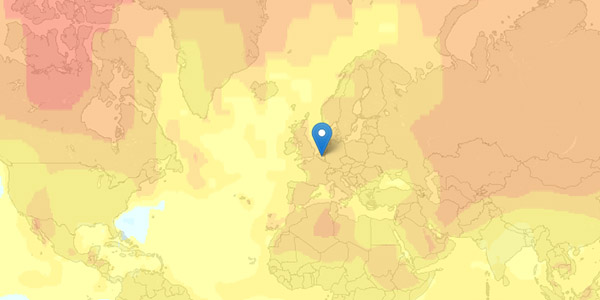
Warming World [newscientistapps.com], developed by Chris Amico and Peter Aldhous for the New Scientist, shows the distribution of ambient temperatures around the world, ranging from 1951 to now. The graphs and maps highlight the changes relative to the average temperatures measured between 1951 to 1980.
Users can click anywhere on the map and investigate an entire temperature record for that grid cell, retrieved via NASA's surface temperature analysis database GISTEMP, which is based on 6000 monitoring stations, ships and satellite measurements worldwide. Via the drop-down list at the top, users can also switch between different map overlays that summarize the average temperatures for different 20-year pictures. Accordingly, climate change become visible as the cool blue hues from previous decades are replaced with warm red and yellow hues around the start of the 20th Century.
Accordingly, this tool aims to communicate the reality and variability of recorded climate change, and compare that local picture with the trend for the global average temperature..
The accompanying article can be found here.
See also Cal-Adapt and Climate Change Media Watch.
----
Read also "An Alarm in the Offing on Climate Change", The New York Times.
Wednesday, January 23. 2013
-----
de noreply@blogger.com (Geoff Manaugh)
[Image: The World Trade Center towers, photographer unknown].
Amongst many other interesting moments in Siobhan Roberts's new biography of Alan Davenport, the "father of modern wind engineering," is the incredible story of a room in Eugene, Oregon.
In August 1965, Roberts explains, "ads in the local newspaper... promised complimentary checkups at the new Oregon Research Institute Vision Research Center." But these promised eye exams were not all that they seemed.
The office was, in fact, a model—a disguised simulation—including a "stereotypical waiting room" where respondents to the ad would be "greeted by a receptionist" who could escort them into a fake "examination room" that turned out to be examining something else entirely.
While members of the public were led through a series of eye tests, looking at "some triangles," in Roberts words, that had been projected onto the wall, they were, in fact, being jostled back and forth, silently and unannounced, by motors installed on tracks below the floor. The room swayed, rocking side to side, shifting imperceptibly—or so the experiment was testing—beneath the feet of the volunteers and the actor-nurses who, without breaking character, took care of them.
It turns out that the whole thing was actually a wind-condition simulator for a pair of buildings that had not yet been publicly announced, let alone constructed: the future twin towers of New York City's World Trade Center. This quiet office in Oregon, paid for by the Port Authority, was an unpublicized test-run for the high winds and other complicated atmospheric effects that would soon rock the two towers back and forth at their unprecedented height in southern Manhattan.
The room, "mounted on a wheeled platform driven by hydraulic actuators," thus tested unsuspecting members of the public for their physiological reaction to the swaying of the floor—testing whether "conflicting brain inputs" from the moving architecture "would cause synaptic confusion, or motion sickness—nausea, dizziness, fatigue," as Roberts writes.
Unbeknownst to them, then, people in Eugene, Oregon, in 1965, were helping to test the aerodynamic flexibility of two buildings that had not yet been announced and that would soon come to dominate the skyline of New York City—leaving at least me to wonder if some room today somewhere, some doctor's office or other nondescript chamber, whether a classroom or a restaurant, is actually a testing ground for as-yet unrealized architectures to come, be it in New York City, Dubai, Mexico City, or, who knows, even for future travelers to the moon.
(Thanks to Nicola Twilley for giving me a copy of Roberts's book).
Personal comment:
Make me think a little bit of both the mystery spot and this other previous article about Julian Hoeber exhibition,Demon Hill.
Friday, January 18. 2013
-----
de Greg J. Smith
While airship construction is not generally within the purview of media artists, a recent project by Karolina Sobecka makes a compelling case for floating personalized weather modification devices up towards the stratosphere. The Cloud Machine is a composite weather balloon and rudimentary cloud seeding apparatus that can create small clouds and make subtle alterations to the atmosphere in the process.
More about it on Creative Applications.
-----
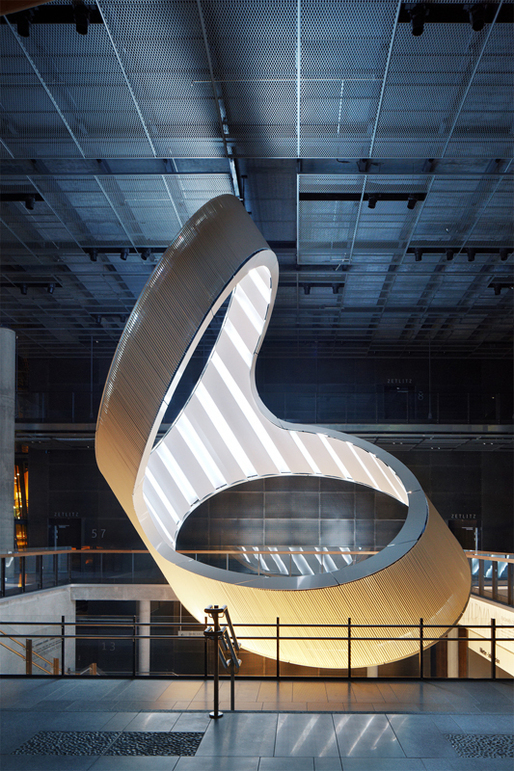
INABA has completed Skylight, a permanent installation for KORO Public Art Norway. The 6.6 m (22 ft) diameter, 11.5 m (38 ft) long structure hangs from the foyer of the New Concert Hall in Stavanger, Norway. It is visible from the adjacent public plaza, and surrounding neighborhood and harbor, serving as a light beacon for the complex. Responding to the region’s extreme atmospheric conditions, Skylight emits a range of pure color light patterns that contrast and complement the blended luminous tones of the dawn and twilight Nordic sky. Conceived of as an inverted chandelier, Skylight’s light fixtures are mounted to face inward and illuminate the structure’s interior surface. Its programmable LED system is animated to change in brightness and hue, and produce distinct patterns during arrival, theater calls, intermission, departure, and after hours.

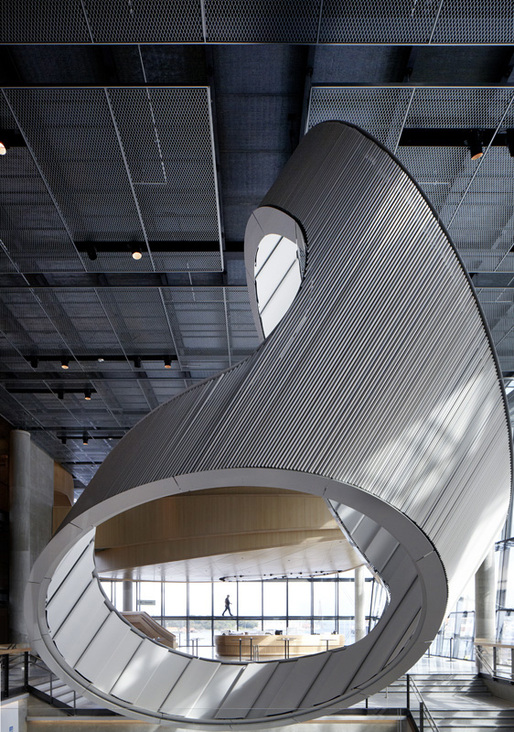
Skylight is based on a simple cylinder. Areas along the surface of the cylinder were removed to create views from the five-stor.
Wednesday, January 16. 2013
Via Dezeen (thanks Christian Babski for the link)
-----

More about it on Dezeen's website.
Friday, December 21. 2012
Via ExtremTech
-----
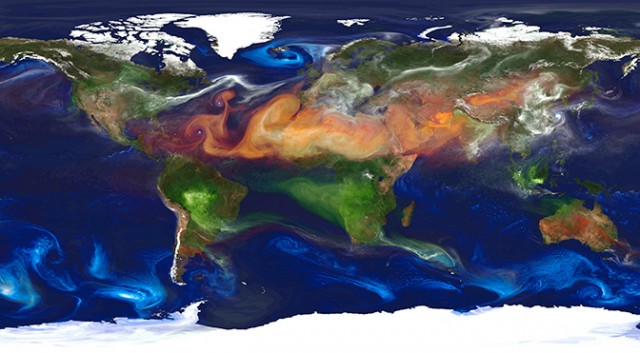
Here’s a mind-blowing view of the Earth that you’ve probably never seen — or even thought of — before. Dubbed “Portrait of Global Aerosols” by NASA, this is the kind of imagery that climate scientists use to analyze the Earth’s atmosphere, the weather, and trends such as global climate change.
Now, first things first: The Earth doesn’t actually look like this from space (alas). Rather, this is an image output by the Goddard Earth Observation System Model, version 5 (GEOS-5). GEOS-5 is an almighty piece of software that runs on a supercomputer at NASA’s Center for Climate Simulation in Maryland.
In the case of this image, GEOS-5 is modeling the presence of aerosols (solid or liquid particles suspended in gas) across the Earth’s atmosphere. Each of the colors represents a different aerosol: Red is dust (swept up from deserts, like the Sahara); Blue is sea salt, swirling inside cyclones; Green is smoke from forest fires; and white is sulfates, which bubble forth from volcanoes — and from burning fossil fuels. The full-size version of the image is particularly mesmerizing, with beautiful swirls of Saharan sand in the Atlantic, and perhaps the tail end of the Gulf Stream circling around Iceland.
It’s hard to be certain, but it seems like the US east coast, central Europe, and east Asia are burning a lot of fossil fuels. Japan, of course, sits on the edge of the Pacific Ring of Fire, so the sulfates there could be from volcanoes. The smoke in Australia is probably from forest fires — but the large volume of smoke from the Amazon rain forest and sub-Saharan Africa is curious. Are these forest fires, or the large-scale burning of wood for heat and power?
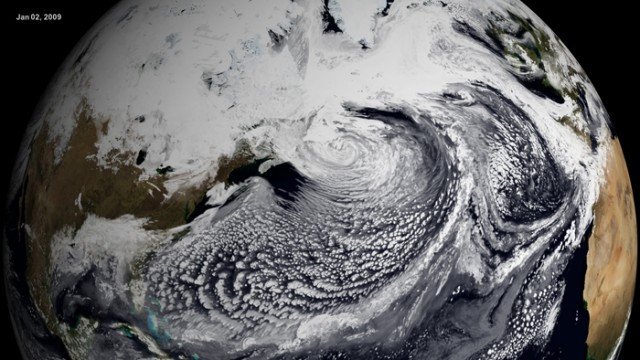
As you can imagine, the amount of raw data required to produce such imagery is immense. Weather modeling is still one of the primary uses of supercomputers. To create the Portrait of Global Aerosols, GEOS-5 will have aggregated the measurements from hundreds of weather stations across Earth, along with data from the four NASA/NOAA GOES weather satellites. So you have some idea of the complexity of the GEOS-5 model, the resolution of this image is 10 kilometers (6 miles) — meaning the Earth has been split into regions (“pixels”) of 10km2, and then the atmospheric conditions are simulated for each region. The surface area of the Earth is 510,072,000km2, which means the total number of regions is around 5 million.
Each of these 5 million pixels might have megabytes or gigabytes of weather data associated with it — and of course, in any given area, the weather in each pixel interacts with those around it. This gives you some idea of how much data needs to be processed and moved around — and it only becomes exponentially more complex as sensors improve (producing more data) and as you increase the depth of your analysis. In the case of climate change, for example, scientists are modeling decades or even centuries of data to try and divine some kind of pattern — a task that taxes even the most powerful supercomputers. If you’ve ever wondered why we keep building faster and faster supercomputers, now you know why.
Now read: What can you actually do with a supercomputer?
|










































